Overview of Accounting Standards – CA Inter Accounts Question Bank is designed strictly as per the latest syllabus and exam pattern.
Overview of Accounting Standards – CA Inter Accounts Question Bank
Question 1.
Accounting Standards are mandatory for all companies.” Comment (Dec 2009, 3 marks)
Answer:
Central Government to prescribe Accounting Standards According to Sec. 133 of Companies Act, 2013, the Central Government may prescribe the standards of accounting or any addendum thereto, as recommended by the Institute of Chartered Accountants of India, constituted under Sec. 3 of the Chartered Accountants Act, 1949, in consultation with and after examination of the recommendations made by the National Financial Reporting Authority. The Accounting Standard are mandatory and applicable to all companies while preparing financial statement of the company.
Where the financial statement of the company do not comply with the accounting standard, such companies shall disclose in its financial statement the following :
- The deviation from the accounting standard;
- The reasons for such deviation; and
- The financial effect, if any, arising due to such deviation.
Question 2.
List the criteria to be applied for rating an enterprise as Level-I enterprise for the purpose of Compliance of Accounting Standards in India. (Nov 2007, 4 marks)
Answer:
Enterprises which fall in any one or more of following categories are classified as level I Enterprise –
- Enterprises, whose equity or debt securities are either listed or are in the process to be listed in India or outside India.
- Banks, Insurance Companies and Financial institutions.
- All commercial, industrial and other reporting business enterprises, whose total turnover during the previous year exceeds ₹ 50 crores (as per the audited financial statement).
- All commercial, industrial and other reporting business enterprises, whose total borrowings including public deposits during the previous year exceeds ₹ 10 crores (as per audited financial statement).
- Holding or subsidiary company of any of the above enterprises any time during the year.
![]()
Question 3.
Answer the following:
List the Criteria for classification of non-corporate entities as level I Entities for the purpose of application of Accounting Standards as per The Institute of Chartered Accountants of India. (Jan 2021, 5 marks)
Question 4.
What are the three fundamental accounting assumptions recognised by Accounting Standard (AS) 1 ? Briefly describe each one of them. (May 2013, 4 marks)
Answer:
Accounting Standard-1 recognizes three fundamental accounting assumptions. These are as follows:
1. Going Concern
The financial statements are normally prepared on the assumption that an enterprise will continue its operations in the foreseeable future and neither there is intention, nor there is need to materially curtail the scale of operations.
2. Consistency The principle of consistency refers to the practice of using same accounting policies for similar transactions in all accounting periods unless the change is required
- by a statute,
- by an accounting standard or
- for more appropriate presentation of financial statements.
3. Accrual Basis of
Under this basis of accounting, transactions are Accounting recognised as soon as they occur, whether or not cash or cash equivalent is actually received or paid.
Question 5.
In the books of M/s Prashant Ltd., closing inventory as on 31.03.2015 amounts to ₹ 1,63,000 (on the basis of FIFO method).
The company decides to change from FIFO method to weighted average method for ascertaining the cost of inventory from the year 2014- 15. On the basis of weighted average method, closing inventory as on 31.03.2015 amounts to ₹ 1,47,000. Realisable value of the inventory as on 31.03.2015 amounts to ₹ 1,95,000.
Discuss disclosure requirement of change in accounting policy as per AS -1. (Nov 2015, 5 marks)
Answer:
As per AS -1, Disclosure of Accounting Policies, accounting policies refers to the accounting principles and method of applying those principles in the preparation and presentation of financial statements.
So if there is change in the accounting policies the firm should disclose in it’s statements:
- The fact that there is change in accounting policy.
- The reason for change in accounting policies.
- The effect of such change in the financial statements.
So in this case M/s. Prashant Ltd. changes valuation of inventory from FIFO to weighted average. Therefore, the firm should disclose in it’s financial statement:
1. There is a change in valuation of inventory from FIFO to weighted average.
2. The reason why such change is to be made: The company values its inventory at lower of cost and net realisable value. Since net realisable value of all items of inventory in the current year was greater than respective costs, the company valued its inventory at cost. In the present year i.e. 2014-15, the company has changed to weighted average method, which better reflects the consumption pattern of inventory, for ascertaining inventory costs from the earlier practice of using FIFO for the purpose.
3. The effect of such change in the financial statement: The change in policy has reduced current profit and value of inventory by ₹ 16,000.
![]()
Question 6.
ABC Financial Services Ltd. is engaged in the business of financial services and is undergoing tight liquidity position, since most of the assets of the company are blocked in various claims/petitions in a Special Court. ABC Financial Services Ltd. has accepted Inter-Corporate Deposits (ICDs) and it is making its best efforts to settle the dues. There were claims at varied rates of interest, from lenders, from the due date of ICDs to the date of repayment. The company has provided interest, as per the terms of the contract till the due date and a note for non-provision of interest from the due date to date of repayment was mentioned in financial statements.
On account of uncertainties existing regarding the determination of the amount and in the absence of any specific legal obligation at present as per the terms of contracts, the company considers that these claims are in the nature of “claims against the company not acknowledged as debt”, and the same has been disclosed by way of a note in the accounts instead of making a provision in the Profit and Loss Account.
State whether the treatment done by the company is correct or not as per relevant Accounting Standard. (May 2017, 5 marks)
Answer:
As per AS -1, “Disclosure of Accounting Policies,” following are considerations that govern selection of a particular Policy:
- Prudence
- Substance over form and
- Materiality
As per the above considerations and in view of uncertainty associated with future events, profits are not anticipated, but losses are provided for as a matter of conservatism. Provision should be created for all known liabilities and losses even though the amount cannot be determined with certainty and represents only a best estimate in the light of available information.
As per AS -1, ‘Accrual’ is one of the fundamental accounting assumptions. Irrespective of the terms of the contract, so long as the principal amount of a loan is not repaid, the lender cannot be placed in a disadvantageous position for non-payment of interest in respect of overdue amount. From the facts given in the question, it is apparent that the company has an obligation to pay because of the overdue interest amount.
Thus, in the given case, ABC Financial Services Ltd. should make provision for interest from the due date of ICDs to date of repayment even though the amount cannot be determined. Thus, it should represent only a best estimate in the light of available information.
Thus, the treatment done by the company that these claims are in nature of “claims against the company not acknowledged as debt” and the disclosure by way of note in the accounts instead of making a provision in the P & L A/c is not correct as per AS -1.
Question 7.
HIL Ltd. was making provision for non-moving stocks based on no issues having occurred for the last 12 months upto 31.03.2017. The company now wants to make provision based on technical evaluation during the year ending 31.03.2018.
Total value of stock ₹ 120 lakhs
Provision required based on technical evaluation ₹ 3.00 lakhs
Provision required based on 12 months no issues ₹ 4.00 lakhs
You are requested to discuss the following points in the light of Accounting Standard (AS) – 1:
(i) Does this amount to change in accounting policy?
(ii) Can the company change the method of accounting? (Nov 2018, 5 marks)
Answer:
The decision of making provision for non-moving inventories on the basis of technical evaluation does not amount to change in accounting policy. Accounting policy of a company may require that provision for non-moving stocks (inventories) should be made. The method of estimating the amount of provision may be changed. In case a more prudent estimate can be made. In the given case, considering the total value of stock, the change in the amount of required provision of non-moving stock from ₹ 4 lakhs to ₹ 3 lakhs is also not material. The disclosure can be made for such change in the following lines by way of notes to the accounts in the annual accounts of HIL Ltd. for the year 2017-18:
“The company has provided for non-moving stocks on the basis of technical evaluation unlike preceding years. Had the same method been followed as in the previous year; the profit for the year and the corresponding effect on the year end net assets would have been lower by ₹ 1 lakh.”
Question 8.
What are the items that are to be excluded in determination of the cost of inventories as per AS – 2? (May 2008, 4 marks)
OR
In determining the cost of inventories, it is appropriate to exclude certain costs and recognize them as expenses in the period in which they are incurred.” Provide example of such costs as per AS-2: Valuation of Inventories. (Nov 2012, 4 marks)
Answer:
Para 13 of AS-2 Valuation of Inventories lists down the specific costs which are to be excluded from cost of inventories.
The list is as follows:
- Abnormal amounts of wasted materials, labour or other production cost.
- Storage costs, unless those costs are necessary in the production process prior to a further production stage.
- Administrative overheads that do not contribute to bringing the inventories to their present location and condition; and
- Selling and distribution costs.
As per Para 12, Interest and other borrowing costs are usually considered as not related to bringing the inventories to their present location and condition and are therefore usually not included in the cost of inventory.
Question 9.
State whether the following statement is ‘True’ or False’. Also give reason for your answer.
3. As per the provisions of AS-2, inventories should be valued at the lower of cost and selling price. (May 2019, 1 mark)
Answer:
False:
As per AS 2, inventories should be valued at the lower of cost and net realiable value.
Net reliable value = Selling Price – Cost necessary to make sell.
![]()
Question 10.
From the following data, find out value of inventory as on 30.04.2009 using
(a) LIFO method, and
(b) FIFO method :
(1) 01.04.2009 Purchased 10 units @ ₹ 70 per unit
(2) 06.04.2009 Sold 6 units @ ₹ 90 per unit
(3) 09.04.2009 Purchased 20 units @ ₹ 75 per unit
(4) 18.04.2009 Sold 4 units @ ₹ 100 per unit. (Nov 2009, 2 marks)
Answer:
(a) Statement showing valuation of closing inventory by LIFO methoc
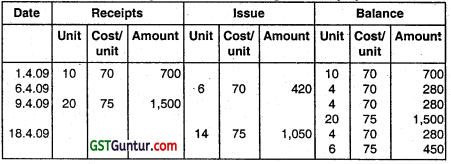
Value of closing inventory as per FIFO method:

(b) Statement showing valuation of closing inventory by FIFO method

Value of closing inventory as per FIFO method:

Question 11.
Raw materials inventory of a company includes certain material purchased at ₹ 100 per kg. The price of the material is on decline and replacement cost of the inventory at the year end is ₹ 75 per kg. It is possible to convert the material into finished product at conversion cost of ₹ 125.
Decide whether to make the product or not to make the product, if selling price is
(i) ₹ 175 and
(ii) ₹ 225. Also find but the value of inventory in each case. (May 2010, 4 marks)
Answer:
Provision:
According to Para 24 of AS-2 ‘Valuation of Inventories’, materials and -other supplies held for use in the production of inventories are not written down below cost if the finished products in which they will be incorporated are expected to be sold at or above cost. But when there has been a decline in the price of materials and it is estimated that the cost of the finished products will exceed net realizable value, the materials are written down to net realisable value.
Analysis and Conclusion:
In such circumstances, the replacement cost of the materials may be the best available measure of their net realisable value.
(i) When the selling price be ₹ 175
Incremental Profit = ₹ 175 – ₹ 125 = ₹ 50
Current price of the material = ₹ 75
Therefore, it is better not to make the product. Raw material inventory would be valued at net realisable value i.e. ₹ 75 because the selling price of the finished product is less than ₹ 225 (100 + 125) per kg.
(ii) When the selling price be ₹ 225
Incremental Profit = ₹ 225 -1125 = ₹ 100
Current price of the raw material = ₹ 75
Therefore, it is better to make the product.
Raw material inventory would be valued at ₹ 100 per kg because the selling price of the finished product is not less than ₹ 225.
Question 12.
HP is a leading distributor of petrol. A detail inventory of petrol in hand is taken when the books are closed at the end of each month. At the end of month following information is available :
Sales : ₹ 47,25,000
General overheads cost : ₹ 1,25,000
Inventory at beginning 1,00,000 litres @ 15/- per litre Purchases
June 1 two lakh litres @ 14.25
June 30 one lakh litres @ 15.15
Closing inventory 1.30 lakh litres
Compute the following by the FIFO as per AS-2 :
(i) Value of Inventory on June 30.
(ii) Amount of cost of goods sold for June.
(iii) Profit/Loss for the month of June. (Nov 2010, 5 marks)
Answer:
(i) Cost of Closing Inventory for 1,30,000 litres as on 30th June

(ii) Computation of Cost of Goods Sold

(iii) Computation of Profit

Question 13.
Best Ltd. deals in five products, P, Q, R, S, and T which are neither similar nor interchangeable. At the time of closing of its accounts for the year ending 31st March 2011, the historical cost and net realisable value of the items of the closing stock are determined as follows:

What will be the value of closing stock for the year ending 31st March, 2011 as per AS-2 “Valuation of inventories”? (May 2011, 4 marks)
Answer:
According to AS 2 “Valuation of Inventories, inventories should be valued at the lower of cost and net realizable value. Inventories should be written down to net realizable value on an iterm-by-item basis.
Valuation of inventory (item wise) for the year ending 31st March 2011
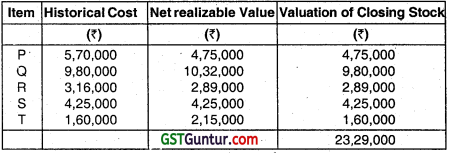
The value of inventory for the year ending 31st March 2011 – ₹ 23,29,000
Question 14.
From the following information ascertain the value of stock as on 31st March, 2012:
Stock as on 01.04.2011 : ₹ 28,500
Purchases : ₹ 1,52,500
Manufacturing Expenses : ₹ 30,000
Selling Expenses : ₹ 12,100
Administration Expenses : ₹ 6,000
Financial Expenses : ₹ 4,300
Sales : ₹ 2,49,000
At the time of valuing stock as on 31st March, 2011 a sum of ₹ 3,500 was written off on a particular item, which was originally purchased for ₹ 10,000 and was sold during the year of ₹ 9,000. Barring the transaction relating to this item, the gross profit earned during the year was 20% on sales. (Nov 2012, 4 marks)
Answer:
Statement showing valuation of stock as on 31.3.2012

Question 15.
On 31st March 2013 a business firm finds that cost of a partly finished unit on that date is ₹ 530. The unit can be finished in 2013-14 by an additional expenditure of ₹ 310. The finished unit can be sold for ₹ 750 subject to payment of 4% brokerage on selling price. The firm seeks your advice regarding:-
(i) the amount at which the unfinished unit should be valued as at 31st March, 2013 for preparation of final accounts and
(ii) the desirability or otherwise of producing the finished unit. (May 2013, 4 marks)
Answer:
Valuation of unfinished unit:


Incremental cost ₹ 310 (cost to complete) is less than incremental revenue ₹ 720 (₹ 750 – ₹ 30). The enterprise will therefore decide to finish the unit for sale at ₹ 750.
Note: The aforesaid solution is based on assumption that partly finished unit cannot be sold in semi finished form and its NRV is zero without processing it further.
![]()
Question 16.
Capital Cables Ltd., has a normal wastage of 4% in the production process. During the year 2013-14 the Company used 12,000 MT of raw material costing ₹ 150 per MT.
At the end of the year 630 MT of wastage was in stock. The accountant wants to know how this wastage is to be treated in the books.
Explain in the context of AS 2 the treatment of normal loss and abnormal loss and also find out the amount of abnormal loss if any. (Nov 2014, 5 marks)
Answer:
According to AS-2, (Revised) ‘Valuation of Inventories’, abnormal amounts of wasted materials, labour and other production costs are excluded from cost of inventories and such costs are recognised as expenses in the period in which they are incurred.
The amount of normal loss will be included in computing the cost of inventories (finished goods) at the year end.
Amount of Abnormal Loss:

Therefore, ₹ 23,437.50 will be charged to the Profit and Loss Statement.
Question 17.
Mr. Mehul gives the following information relating to items forming part of inventory as on 31-3-2015. His factory produces Product X using Raw material A.
(i) 600 units of Raw material A (purchased @ ₹ 120). Replacement cost of raw material A as on 31 -3-2015 is ₹ 90 per unit.
(ii) 500 units of partly finished goods in the process of producing X and cost incurred till date ₹ 260 per unit. These units can be finished next year by incurring additional cost of ₹ 60 per unit.
(iii) 1500 units of finished Product X and total cost incurred ₹ 320 per unit. Expected selling price of Product X is ₹ 300 per unit.
Determine how each item of inventory will be valued as on 31-3-2015. Also calculate the value of total inventory as on 31 -3-2015. (May 2015, 5 marks)
Answer:
(i) Valuation of Raw Material: If finished product is expected to be sold below cost then raw material should be valued at NRV if there is decline in price of material. In such circumstances, the replacement cost of materials may be best available measure of their net realizable value.
Here product x is expected to be sold at ₹ 300 per unit which is below than total cost per unit which is ₹ 320. Then raw material is to be valued at replacement cost.
So, valuation of raw material is done as follows:
No. of units × Replacement Cost/unit = 600 × 90 = ₹ 54,000
Raw material is to be valued at ₹ 54,000
(ii) Valuation of WIP : 500 units of partly finished goods will be valued at ₹ 240 per unit i.e. lower of cost ₹ 320 (₹ 260 + additional cost ₹ 60) or Net estimated selling price ₹ 240 (Estimated selling price ₹ 300 per unit less additional cost of ₹ 60).
(iii) Cost of Finished Goods: As per AS-2, inventory is to be valued at cost or realizable value which ever is lower. Here the cost of finished good is ₹ 320 per unit and finished good is expected to be sold at ₹ 300 which is less than the cost of finished goods. So, finished good is valued at expected selling price, as calculated follows:
1500 units × ₹ 300 per unit = ₹ 4,50,000
So, finished good is valued at ₹ 4,50,000 to the year end.
Valuation of Total inventory as on 31 .3.2015

Question 18.
Z Limited ordered 13,000 kg. of chemicals at ₹ 90 per kg. The purchase price includes GST of ₹ 5 per kg. in respect of which full Input credit is admissible. Freight incurred amounted to ₹ 30,000. Normal transit loss is 4%. The company actually received 12,400 kg. and consumed 10,000 kg. The company has received trade discount in the form of cash amounting to ₹ 1 per kg. The chemicals were delivered in containers. The containers were not reusable, hence sold for ₹ 500. The administrative expenses incurred to bring the chemicals were ₹ 10,000.
Compute the value of inventory and allocate the material cost as per AS-2. [Modified] (May 2016, 5 marks)
Answer:
Cost of Inventory and allocation of material cost is shown below:
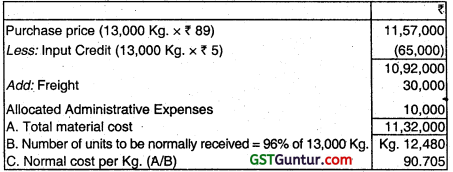
Allocation of Material cost:

The difference due to rounding off of normal cost per Kg. has been adjusted. Thus the inventory will be valued at ₹ 2,17,692.
Note:
1. The Company has received trade discount In the form of cash. Therefore, discount has been treated as trade discount in the given answer.
2. Abnormal losses are recognized as separate expenses.
3. Containers are used for delivery of the chemicals and are not reusable. Cost of these containers is treated as selling and distribution expense. The sale value of these containers will be credited to Profit and Loss Account and shall not be considered for the purpose of valuation of inventory.
Alternatively, the sales value of container amount of ₹ 500 may be deducted, while computing material cost. In that case the material cost will be computed as ₹ 11,31,500(11,32,000-500) instead of ₹ 11,32,000.
Accordingly the allocation of material cost will get changed.
Question 19.
A Limited is engaged in manufacturing of Chemical Y far which Raw Material X is required. The company provides you following information for the year ended 31st March, 2017.
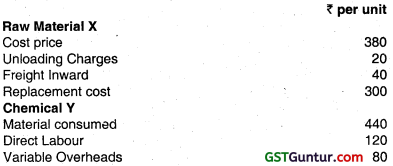
Additional Information:
(i) Total fixed overhead for the year was ₹ 4,00,000 on normal capacity of 20,000 units.
(ii) Closing balance of Raw Material X was 1,000 units and Chemical Y was ₹ 2,400 units.
You are required to calculate the total value of closing stock of Raw Material X and Chemical Y according to AS 2, when
(a) Net realizable value of Chemical Y is ₹ 800 per unit
(b) Net realizable value of Chemical Y is ₹ 600 per unit (Nov 2017, 5 marks)
Answer:
Valuation of finished goods stock:
(a) Cost per unit of finished goods:

∴ Cost per unit of finished goods = ₹ 660 per unit
(b) Valuation of finished goods will be:
if NRV is ₹ 800 per unit,
Value per unit (Lower of cost 660 & NRV) = 660
Total value of finished goods stock = ₹ 660 × 2400 units
= ₹ 15,84,000
If NRV is ₹ 600 per unit,
Value per unit (Lower of cost 660 & NRV) = 600
Total value of finished goods stock = ₹ 600 × 2400 units
= ₹ 14,40,000
Valuation of Raw Materials:
(a) Cost per unit of Raw Material:

(b) Total value of Raw Materials (Closing Stock)
1. Finished Goods are valued at cost
- Raw Materials cost per unit ₹ 440
- Replacement cost per unit ₹ 300
- Relevant value per unit ₹ 440 [Since finished goods are valued at cost.]
- Total value for 1.000 units = 1000 × ₹ 440
= ₹ 440,000
2. Finished goods are valued at NRV
- Raw Materials cost per unit ₹ 440
- Replacement cost per unit ₹ 300
- Relevant value per unit ₹ 300 [Since finished goods are valued at NRV]
- Total value for ₹ 1,000 units = 1000 × ₹ 300
= ₹ 3,00,000
![]()
Question 20.
Wooden Plywood Limited has a normal wastage of 5% in the production process. During the year 2017-18 the Company used ₹ 16,000 MT of Raw material costing ₹ 190 per MT. At the end of the year, 950 MT of wastage
was in stock. The accountant wants to know how this wastage is to be treated in the books.
You are required to:
1. Calculate the amount of abnormal toss.
2. Explain the treatment of normal loss and abnormal loss.
[In the context of AS-2 (Revised)] (May 2019, 5 marks)
Answer:
As per AS 2 (Revised) ‘Valuation of Inventories’, abnormal amounts of wasted materials, labours and other production costs are excluded from cost of inventories and such costs are recognised as expenses in the period in which they are incurred. The normal loss will be included in determining the cost of inventories (finished goods) at the year end.
Amount of Abnormal loss:
Material used 16000 MT @ ₹ 190 = ₹ 30,40,000
Normal loss (5% of 16000 MT) 800 MT
Net quantity of material 15,200 MT
Abnormal loss in quantity 150 MT
Abnormal loss ₹ 30,000
(150 units @ ₹ 200 (\(\frac{₹ 30,40,000}{15,200}\))
Amount of ₹ 30,000 will be charged to the Profit and Loss Statement.
Question 21.
Mr. Rakshit gives the following information relating to items forming part of inventory as on 31st March, 2019. His factory produces product X using raw material A.
(i) 800 units of raw material A (purchased @ ₹ 140 per unit).
Replacement cost of raw material A as on 31st March, 2019 is ₹ 190 per unit.
(ii) 650 units of partly finished goods in the process of producing X and cost incurred till date ₹ 310 per unit. These units can be finished next year by incurring additional cost of ₹ 50 per unit.
(iii) 1,800 units of finished product X and total cost incurred ₹ 360 per unit.
Expected selling price of product X is ₹ 350 per unit.
In the context of AS-2, determine how each Item of inventory will be valued as on 31st March, 2019. Also, calculate the value of total inventory as on 31st March. 2019. (Nov 2019, 5 marks)
Answer:
As per AS 2 (Revised) “Valuation of Inventories”, materials and other supplies held for use in the production of inventories are not written down below cost if the finished products in which they will be Incorporated are expected to be sold at cost or above cost. However, when there has been a decline in the price of materials and it is estimated that the cost of the finished products will exceed not realisable value, the materials are written down to net realisable value. In such circumstances, the replacement cost of the materials, may be the best available measure of their net realisable value. In the given case, selling price of product X is ₹ 350 and total cost per unit for production is ₹ 360.
Hence the valuation will be done as under:
- 800 units of raw material A will be valued at cost of 140 per unit as being lower of cost and Replacement Cost
- 650 units of partly finished goods will be valued at ₹ 300 per Unit i.e. lower of cost (₹ 310) or Net realisable value ₹ 300 (Estimated Selling Price ₹ 350 per unit less addition cost ₹ 50)
- 1800 units of finished product X will be valued at NRV of ₹ 350 per unit since it is lower than cost 360 per unit of product X.
Valuation of Total Inventory as on 31.03.2019:

Note: It has been assumed that the partly finished unit cannot be sold in semi-finished form and Its NRV is zero without processing it further.
Question 22.
Answer the following:
Mr. Jatin gives the following information relating to the items forming part of the inventory as on 31.03.2019. His enterprise produces product P using Raw Material X.
(i) 900 units of Raw Material X (purchased @ ₹ 100 per unit). Replacement cost of Raw Material X as on 31.03.2019 is ₹ 80 per unit.
(ii) 400 units of partly finished goods In the process of producing P. Cost incurred till date is ₹ 245 per unit. These units can be finished next year by incurring additional cost of ₹ 50 per unit.
(iii) 800 units of Finished goods P and total cost incurred is ₹ 295 per unit.
Expected selling price of product P is 280 per unit, subject to a payment of 5% brokerage on selling price.
Determine how each item of inventory will be valued as on 31.03.2019. Also calculate the value of total Inventory as on 31.03.2019. (Jan 2021, 5 marks)
Question 23.
In the case of a manufacturing company:
(i) List the items of inflows of cash receipts from operating activities;
(ii) List the items of ‘outflows” of investing activities (2 × 2 = 4 marks)
Answer:
(i) Inflows of cash receipts from operating activities:
(a) Cash receipts from rendering of services.
(b) Cash receipts from the sale of goods.
(c) Refund of income-tax.
(d) Royalties, fees, commission and other revenues.
(ii) Outflows of Investing activities:
(a) Cash payment for acquiring fixed assets.
(b) Cash advances and loans to third parties.
(c) Cash payment for acquisition of shares, warrants or debt instruments of other enterprises and interest in joint ventures.
Question 24.
What are the main features of the cash flow statement? Explain with special reference to AS 3? (Nov 1999, 5 marks)
Answer:
Main features of Cash Flow Statements (As per AS-3):
1. According to AS-3, cash flow statement deals with the provisions of information about the historical changes in cash and cash equivalents of an enterprise during the stated period from operating, investing and financing activities.
2. Cash flow from operating activities can be reported using either:
- the direct method, in which mostly the classes of gross cash receipts and gross cash payments are disclosed.
- the indirect method, in this net profit or loss is adjusted for the purpose of transactions of non-cash nature.
3. According to AS-3, an enterprise must disclose the components of cash and cash equivalents and must present a reconciliation of amounts in its cash flow statement with the equivalent items reported In the balance
sheet.
4. When the cash flow statement is used along with the other financial statements, it provides information that enables the user to evaluate the changes in net assets of an enterprise. This statement also enhances
the comparability of the operating performances.
5. For companies listed on stock exchanges compliance of AS-3 is compulsory due to the listing agreement.
Question 25.
Define briefly the classification of activities, as suggested in Accounting Standard 3, to be used for preparing a cash flow statement. Give two examples of each such class of activities. (May 2001, 4 marks)
Answer:
According to AS-3 (Cash Flow Statement), the cash flow statement must report cash flows by operating, investIng and financing activities:
1. Operating Activities
These are the principal revenue producing activities of the enterprise. This activity does not include in it the investing and financing activities.
Examples of operating activities are cash receipt from the sale of goods and cash payment to the supplier of goods.
2. Investing Activities
These activities include the acquisition and disposal of long-term assets and other investments which are not included in cash equivalents.
Example of investing activities are paymeñt made on acquiring building for business or cash received from the sale of furniture.
3. Financing Activities
Those activities that results in changes in the size and composition of the owners capital and borrowing of the enterprise.
Example of the financing activities are cash proceed from issue of shares and cash paid to redeem debentures.
Question 26.
Classify the following activities as per AS-3 Cash Flow Statement:
(i) Interest paid by financial enterprise
(ii) Dividend paid
(iii) Tax deducted at source on interest received from subsidiary company
(iv) Deposit with Bank for a term of two years
(v) Insurance claim received towards loss of machinery by fire
(vi) Bad debts written off
Which activity does the purchase of business falls under and whether netting off of aggregate cash flows from disposal and acquisition of business units is possible? (May 2016, 4 marks)
Answer:
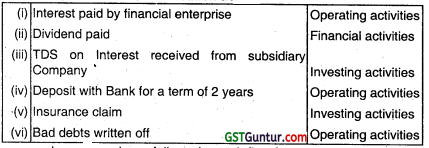
Purchase of business falls under cash flow from investing activities or operating activities depending upon situation.
No cash flows from Disposal and acquisition of business.
Question 27.
Classify the following activities as
(i) Operating Activities,
(ii) Investing activities,
(iii) Financing activities and
(iv) Cash Equivalents.
1. Cash receipts from Trade Receivables
2. Marketable Securities
3. Purchase of investment
4. Proceeds from long term borrowings
5. Wages and Salaries paid
6. Bank overdraft
7. Purchase of Goodwill
8. Interim dividend paid on equity shares
9. Short term Deposits
10. Underwriting commission paid. (May 2018,5 marks)
Answer:
Classification of Activities
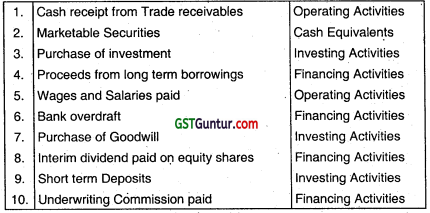
Question 28.
Answer the following questions:
(a) Prepare cash flow from investing activities as per AS 3 of M/s Subham Creative Limited for year ended 31.3.2019.
Particulars : Amount (₹)
Machinery acquired by issue of shares at face value : ₹ 2,00,000
Claim received for loss of machinery in earthquake : ₹ 55,000
Unsecured loans given to associates : ₹ 5,00,000
nterest on loan received form associate company : ₹ 70,000
Pre-acquisition dividend received on Investment made : ₹ 52,800
Debenture interest paid : ₹ 1,45,200
Term loan repaid : ₹ 4,50,000
Interest received on investment (TDS of ₹ 8,200 was deducted on the above interest) 73,800
Purchased debentures of X Ltd., on 1st December, 2018 which are redeemable within 3 months 3,00,000
Book value of plant & machinery sold (loss incurred ₹ 9,600) 90,000 (May 2016, 5 marks)
Answer:
Cash Flow Statement from Investing Activities of M/s Subham Creative Limited for the year ended 31-03-2019:
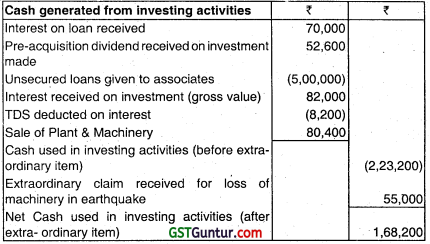
Note:
- Debenture interest paid and Term Loan repaid are financing activities and therefore not considered for preparing cash flow from investing activities.
- Machinery acquired by issue of shares does not amount to cash outflow, hence also not considered in the above cash flow statement.
- Purchase of debentures of X Ltd. on 1st December, 2018 which are redeemable within 3 months to be considered as cash equivalents and not part of financing activities.
Question 29.
Mention four Assets, where AS – 10 is not applicable. (Nov 2008, 2 marks)
Answer
AS-10 deals with “Property, Plant and Equipment”.
This Standard does not apply to:
1. Biological assets related to agricultural activity other than bearer plants. This Standard applies to bearer plants but it does not apply to the produce on bearer plants; and
2. Wasting assets including mineral rights, expenditure on the exploration for and extraction of minerals, oil, natural gas and similar non-regenerative resources.
However, this Standard applies to property, plant and equipment used to develop or maintain the assets described in (a) and (b) above.
![]()
Question 30.
What is the accounting entry to be passed as per AS-10 for the following situations;
(a) Increase in value of PPE by ₹ 50,00,000 on account of revaluation.
(b) Decrease in the value of PPE by ₹ 30,00,000 on account of revaluation. (May 2008, 2 marks)
Answer:

Note: It has been assumed that both the above instances are independent of each other and revaluation Is done for first time.
Question 31.
A company acquired a machine on 1.4.2006 for ₹ 5,00,000. The company charged depreciation upto 2008-09 on straight line basis with estimated working life of 10 years and scrap value of ₹ 50,000. From 2009 -10. the company decided to change depreciation method at 20% on reducing balance method. Compute the amount of depreciation to be debited to Profits and Loss A/c for the year 2009 – 10. (May 2010, 2 marks)
Answer:
Annual depreciation charged by the company up to 2008-09
\(=\frac{\text { Cost price of the machine-Scrap value }}{\text { Useful life of the machine }}\)
\(\frac{₹ 5,00,000-₹ 50,000}{10}\) = ₹ 45,000
WDV of machine at the end of 2008-09 by Straight Line Method (SLM)
= ₹ 5,00,000 – (₹ 45,000 × 3) = ₹ 3,65,000
Depreciation to be charged in 2009-2010
Book value of the machine as per SLM as on 2008-09 = 3,65,000
Dep. to be charged = 3,65,000 × \(\frac{20}{100}\) = 73,000
Question 32.
During the current year 2009 – 10 M/s L & C Ltd. made the following expenditure relating to its plant and machinery:
General repairs : ₹ 4,00,000
Repairing of Electric Motors : ₹ 1,00,000
Partial Replacement of parts of Machinery : ₹ 50,000
Substantial improvements to the electrical wiring system which will increase efficiency of the plant and machinery : ₹ 10,00,000
What amount should be capitalised according to AS-10? (May 2010, 4 marks)
Answer:
Provision:
According to AS-10 Property, Plant and Equipment, the cost of an item of PPE shall be recognised as an asset if and only if
- It is probable that future economic benefits associated with the item will flow to the firm,
- The cost can be measured, reliably.
Analysis and Conclusion:
Therefore, in the given case, repairs amounting ₹ 5 lakhs and partial replacement of parts of machinery worth ₹ 50,000 should be charged to statement of profit & loss. ₹ 10 lakhs incurred for substantial improvement to the electrical wiring system which will increase efficiency should be capitalized.
Question 33.
Carrying amount of a machine is ₹ 1,00,000 (Historical cost less depreciation). The machine is expected to generate ₹ 25,000 net cash flow for 5 years. The net realizable value (or net selling price) of the machine on current date is ₹ 85,000. The enterprises required rate of earning is 10% p.a. State the value at which the enterprise should carry its machine. The present value factors at 10% are 0.909, 0.826, 0.751, 0.683 and 0.621 at the end of first, second, third, fourth and fifth year respectively. (May 2011, 4 marks) [IPCC Gr. II]
Answer:
Value in use is the present value of estimated future cash flow expected to arise from the continuing use of an asset. Therefore,
Value in use = ‘₹ 25,000 × (0.909 +0.826 + 0.751+ 0.683 + 0.621) ₹ 94,750 Net selling price = ₹ 85,000
Recoverable amount is the higher of an asset’s value in use and its net selling price i.e.94,750.
Carrying value of a machine = ₹ 1,00,000 (recorded in the books)
Carrying amount is the amount at which an asset is recognized in the balance sheet after deduction any accumulated depreciation (amortization) and accumulated impairment losses thereon.
In the given case, carrying amount of machine will be lower of its recoverable amount ₹ 94,750 and its book value i.e. ₹ 1,00,000. Therefore, the enterprise should carry its machine at value of ₹ 94,750.
Question 34.
In the Trial Balance of M/s Sun Ltd. as on 31-3-2011, balance of machinery appears ₹ 5,60,000. The company follows rate of depreciation on machinery @ 10% p.a. On scrutiny it was found that a machine appearing in the books on 1-4-2010 at ₹ 1,60,000 was disposed of on 30- 9-2010 at ₹ 1,35,000 in part exchange of a new machine costing ₹ 1,50,000.
You are required to calculate:
(i) Total depreciation to be charged in the Profit and Loss Account.
(ii) Loss on exchange of machine.
(iii) Book value of machinery in the Balance Sheet as on 31 -3-2011. (Nov 2011, 5 marks)
Answer:
Assumption: The question has been solved on the basis of written down value method due to absence of related information regarding straight line method.
(i) Total Depreciation to be charged in the statement of Profit and Loss
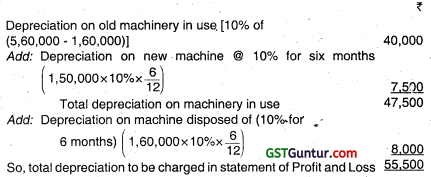
(ii) Loss on Exchange of Machine Particulars

(iii) Book Value of Machinery in the Balance Sheet as on 31.03.2011

Question 35.
M/s. Tiger Ltd. allotted 7500 equity shares of 100 each fully paid up to Lion Ltd. in consideration for supply of a special machinery. The shares exchanged for machinery are quoted at National Stock Exchange (NSE) at ₹ 95 per share at the time of transaction. In the absence of fair market value of the mach nery acquired, how the value of the machinery would be recorded in the books of Tiger Ltd? (May 2012, 4 marks)
Answer:
Provision:
According to AS 10 ‘Property, Plant and Equipment:’
Depreciation is a measure of wearing out, consumption or other loss of value of a depreciable asset arising from use, effluxion of time or obsolescence through technology and market changes.
Accordingly, depreciation may arise even when asset has not been used in the current year but was ready for use in that year.
The need for using the stand by bus may not have arisen during the year but that does not imply that the useful life of the bus has not been affected. Therefore, non-provision of depreciation on the ground that the bus was not used during the year is not tenable.
As per AS-10, ‘Property, Plant and Equipment,’ the gross book value of the self constructed fixed asset includes the costs of construction that relate directly to the specific asset and the costs that are attributable to the construction activity in general can be allocated to the specific asset.
If any Internal profit is there it should be eliminated. Saving of ₹ 1,50,000 on account of using its own workforce is an unrealized/internal profit, which should not be capitalized/recorded as per the standard.
Analysis and Conclusion:
Therefore only ₹ 4,50,000 should be debited to the factory building account and not ₹ 600,000.
Hence, the contention of the directors of the company to capitalize ₹ 6,00,000 as cost of factory building, on the ground that the company is killy entitled to employ an outside contractor is not justifiable.
Question 36.
A computer costing ₹ 60,000 is depreciated on straight line basis, assuming 10 years working life and Nil residual value, for three years. The estimate of remaining useful life after third year was reassessed at 5 years. Calculate depreciation as per the provisions of Accounting Standard 10 “Property, Plant and Equipment. (May 4 marks)
Answer:
Depreciation per year = ₹ 60,000/10 = ₹ 6,000
Depreciation on SLM charged for three years = ₹ 6,000 × 3 years = ₹ 18,000
Book value of the computer at the end of third year = ₹ 60,000 – ₹ 18,000
= ₹ 42,000
Remaining useful life as per previous estimate = 7 years
Remaining useful life as per revised estimate = 5 years
Depreciation from the fourth year onwards = ₹ 42,000/5 = ₹ 8,400 per annum
Question 37.
PQR Ltd. constructed a fixed asset and incurred the following expenses on its construction:
Materials : ₹ 16,00,000
Direct Expenses : ₹ 3,00,000
Total Direct Labour : ₹ 6,00,000
(1/15th of the total labour time was chargeable to the construction)
Total Office & Administrative Expenses 9,00,000
(4% is chargeable to the construction)
Depreciation on assets used for the construction of this asset 15,000
Calculate the cost of the fixed asset. (Nov 2012, 4 marks)
Answer:
Calculation of cost of fixed assets

Note: It is assumed that 4% of office and administrative expenses are specifically attributable to construction of a fixed asset. Alternatively, it may be assumed that 4% of office and administrative expenses are only allocated to construction project and is not specifically attributable to it. In such a case, the cost of fixed assets will be ₹ 19,55,000.
Question 38.
Amna Ltd. contracted with a supplier to purchase a specific machinery to be installed in Department A in two months time. Special foundations were required for the plant, which were to be prepared within this supply lead time. The cost of site preparation and laying foundations were ₹ 47,290. These activities were supervised by a technician during the entire period, who is employed for this purpose of ₹ 15,000 per month. The Technician’s services were given to Department A by Department B. which billed the services at ₹ 16,500 per month after adding 10% profit margin.
The machine was purchased at ₹ 52,78,000. GST was charged at 18% on the invoice. ₹ 18,590 transportation charges were incurred to bring the machine to the factory. An Architect was engaged at a fee of ₹ 10,000 to supervise machinery installation at the factory premises. Also, payment under the invoice was due in 3 months. However, the Company made the payment in 2nd month. The company operates on Bank Overdraft @ 11%. Ascertarn the amount at which the asset should be capitalized under AS 1o. (Nov 2013, 5 marks)
Answer:
Cost of machinery is calculated as under:
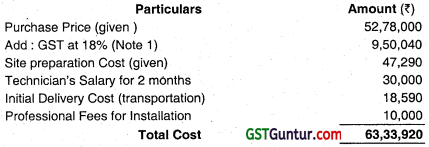
Note:
- 18% of 52,78,000 = ₹ 9,50,040
- Interest on Bank overdraft for earlier payment of invoice is not relevant under AS – 10.
- Internally booked profits should be eliminated in arriving àt the cost of Fixed Assets.
- It has been assumed that the purchase price of ₹ 52,78,000 excludes amount of GST.
Question 39.
On 01.04.2010 a machine was acquired at ₹ 4,00,000. The machine was expected to have a useful life of 10 years. The residual value was estimated at 10% of the original cost. At the end of the 3rd year, an attachment was made to the machine at a cost of ₹ 1,80,000 to enhance its capacity. The attachment was expected to have a useful life of 10 years and zero terminal value. During the same time the original machine was revalued upwards by ₹ 90,000 and remaining useful life was reassessed at 9 years and residual value was reassessed at NIL.
Find depreciation for the year, if
(i) attachment retains its separate identity.
(ii) attachment becomes integral part of the machine, (May 2014, 5 marks)
Answer:
(i) disposed a machine having attachment retains its Separate Identity
Cost of Machine on 1.4.10 = 4,00,000
Less: Residual Value 10% = 40,000
Depreciable Value = 3,60,000
Estimated Useful life = 10 years
Dep. p.a. = 3,60,000 ÷ 10 = ₹ 36,000
Total Dep in 3 years = 36,000 × 3 = ₹ 1,08,000
WDV for 4th year = 4,00,000 – 1,08,000 = 2,92,000
Upward Revaluation of Original Machine = 90,000
WDV for 4th year after revaluation = 2,92,000 + 90,000 = 3,82,000
Remaining useful life = 9 years
Dep. in 4th year = 3,82,000 ÷ 9
Dep. on attachment = 1,80,000 ÷ 10
Total Depreciation = 42,444 + 18,000 = ₹ 60,444
Note:
1 Since, upward revaluation of the machine and reassessment of remaining useful life had been made at the end of the 3rd year, it is implied that depreciation for the 3rd year has been charged on the basis of od calculation & remaining useful life of 9 years is to be calculated from the beginning of the 4th year onwards.
2. Depreciation for The 4th year i.e. 2013-14 has been given in the solution.
(ii) If attachment becomes Integral part of Machine
In this case it will be added to the value of machine and depreciated along with machine over the life of machine.
Value of Machine after Revaluation = 3,82,000
Add: Cost of Attachment = 1,80000
Total Value = 5,62000
Life = 9 years
Depreciation = 5,62,000 ÷ 9 = ₹ 62,444
![]()
Question 40.
In the books of Optic Fiber Ltd., plant and machinery stood at ₹ 6,32,000 on 1.4.2013. However on scrutiny it was found that machinery worth ₹ 1,20,000 was included in the purchases on 1.6.201 3. On 30.6.2013 the company disposed a machine having book value of ₹ 1,89,000 on 1.4.2013 at ₹ 1,75,000 in part exchange of a new machine costing ₹ 2,56,000. The company charges depreciation @ 20% WDV on plant and machinery.
You are required to calculate:
(i) Depreciation to be charged to P/L
(ii) Book value of Plant and Machinery A/c as on 31.3.2014
(iii) Loss on exchange of machinery. (Nov 2014, 5 marks)
Answer:
(i) Depreciation to be charged in the statement of Profit and Loss
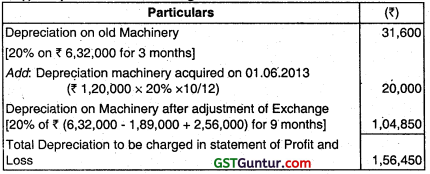
(ii) Book Value of Plant and Machinery A/c as on 31 .03.2014
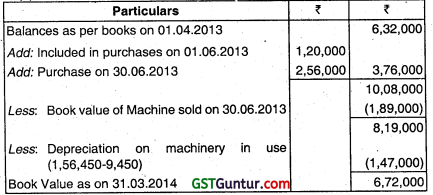
(iii) Loss on exchange of Machinery

Question 41.
From the following information state the amount to be capitalized as per AS 10. Give the explanations for your answers.
₹ 5 lakhs as routine repairs and ₹ 1 lakh on partial replacement of a part of a machine.
₹ 10 lakhs on replacement of part of a machinery which will improve the efficiency of a machine. (Nov 2014, 4 marks)
Answer:
As per AS-10 “Property, Plant and Equipment”, only those expenditures that increase the future benefits tram the existing assets, beyond its previously assessed standard of performance, are to be included in the gross book value.
Hence, in the given case, amount of ₹ 5 lakhs spent on routine repairs and ₹ 1 lakh on partial replacement of a part of the machinery should be charged to Profit and Loss Account as these amounts will help in maintaining the capacity but will not improve the efficiency of the machine.
However, ₹ 10 Lakhs incurred on replacement of a part of the machinery, which will increase the efficiency of a machine, should be capitalized by inclusion in the gross book value of machinery.
Question 42.
Versatile Limited purchased Machinery for ₹ 4,80,000 (inclusive of GST of ₹ 40,000). Input Tax credit is available for the GST paid. The Company incurred the following other expenses for installation.
Particulars : ₹
Cost of preparation of Site for installation : 21,000
Total labour charges (200 out of the total 600 man hours worked, were spent for installation of the Machinery) : 66,000
Spare parts and tools consumed in installation : 6,000
Total salary of supervisor (time spent for installation was 25% of the total time worked) : 24,000
Total administrative expenses (1/10 relates 40 the plant installation) : 32,000
Test rup and experimental production expenses : 23,000
Consultancy charges to architect for plant set up : 9,000
Depreciation on assets used for the installation : 12,000
The Machine was ready for use on 15th January but was used from 1st February. Due to this delay further costs ₹ 19,000 were incurred. Calculate the value at which the plant should be capitailzed. [Modified] (May 2015, 4 marks)
Answer:
Cost of PPE (ie. Machine) is calculated as under
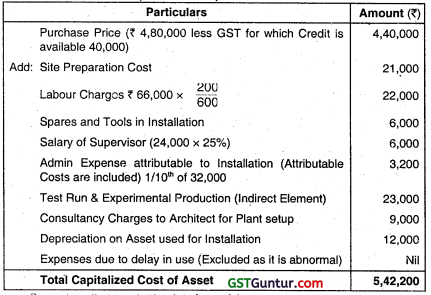
Question 43.
A machinery with a useful life of 6 years was purchased on 1st April, 2012 for ₹ 1,50,000. Depreciation was provided on straight line method for first three years considering a residual value of 10% of cost.
In the beginning of fourth year the company reassessed the remaining useful life of the machinery at 4 years and residual value was estimated at 5% of original cost.
The accountant recalculated the revised depredation historically and charged the difference to profit and loss account. You are required to comment on the treatment by accountant and calculate the depreciation to be charged for the fourth year. (Nov 2015, 5 marks)
Answer:
According to AS-10 “Property, Plant and Equipment”, if the depreciable assets are revalued, the provision for depreciation should be based on the revalued amount and on the estimate of the remaining useful lives of such assets. In case the revaluation has a material effect on the amount of depreciation, the same should be disclosed separately in the year in which revaluation is carried out.
As per the standard, when there is a revision of the estimated useful life of an asset, the unamortized depreciable ãmount should be charged over the revised remaining useful life. Accordingly revised depreciation shall be calculated prospectively. Thus, the treatment done by the accountant regarding recalculating the revised depreciation historically i.e. retrospectively is incorrect.
Calculation of Depreciation
Depreciation per year charged for first three years = ₹ 1,35,000 /6 = ₹ 22,500
WDV of the machine at the beginning of the fourth year = ₹ 1,50,000 – (₹ 22500 × 3)
= ₹ 82,500
Depreciable amount after reassessment of residual value = ₹ 82,500 – 7,500
= 75,000
Remaining useful life as per revised estimate = 4 years
Depreciation from the fourth year onwards = ₹ 75,000/4
= ₹ 18,750
Question 44.
Hema Ltd. purchased a machinery on 1.04.2008 for ₹ 15,00,000. The company charged straight line depreciation based on 15 years working life estimate and residual value ₹ 3,00,000. At the beginning of the 4 year, the company by way of systematic evaluation revalued the machinery upward by 20% of net book value as on date and also re-estimated the useful life as 7 years and scrap value as nil. The increase in net book value was credited directly to revaluation reserves. Depreciation (on SLM basis) later on was charged to Profit & Loss Account. At the beginning of 8th year the company decided to dispose off the machinery and estimated the realizable value to ₹ 2,00,000.
You are required to ascertain the amount to be charged to Profit & Loss Account at the beginning of 8th year with reference to AS-10. (Nov 2016, 5 marks)
Answer:
Calculation of Depreciation:
Cost of Machinery as on 1.4.2008 = ₹ 15,00,000
Depreciation p.a. = \(₹ \frac{15,00,000-3,00,000}{15}\)
= ₹ 80,000
∴ Depreciation for 3 years (1.4.2008 to 31.3.2011) = ₹ 80,000 × 3
= ₹ 2,40,000
∴ Net Book Value of Machinery as on 1.4.2011

Thus:
Increase in Revaluation to be taken to Revaluation Reserve
= ₹ 12,60,000 — ₹ 15,12,000 = ₹ 2,52,000
Revised Depreciation (p.a.) = \(\frac{₹ 15,12,000-\mathrm{Nil}}{7}\) = ₹ 2,16,000
(Assumption: Useful life = 7 years)
∴ Depreciation br years (1.04.2011 to 31 03.2015)
= ₹ 2,16,000 × 4 = ₹ 8,64,000
Thus:
Net Book Value of Machinery as on 1.4.2015:
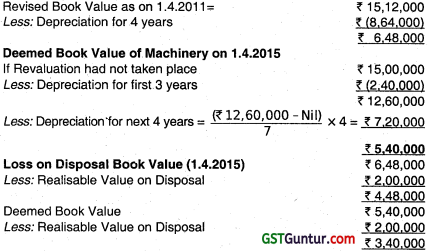
Thus:
Loss to be debited (Adjusted in Revaluation Reserve)
= ₹ 4,48,000 — ₹ 3,40,000 = ₹ 1,08,000
Amount to be debited (Adjusted in Profit and Loss A/c)
= ₹ 4,48,000 — 1,08,000 = ₹ 3,40,000
Balance in Revaluation Reserve transferred to General Reserve
= ₹ 2,52,000 – ₹ 1,08,000 = ₹ 1,44,000.
![]()
Question 45.
ABC Ltd. Is installing a new plant at its production facility. It provides you the following information:
Cost of the plant (cost as per suppliers invoice) : ₹ 31,25,000
Estimated dismantling costs to be incurred after 5 years : ₹ 2,50,000
Initial Operating losses before commercial production : ₹ 3,75,000
Initial delivery and handling costs : ₹ 1,85,000
Cost of site preparation : ₹ 4,50,000
Consultants used for advice on the acquisition of the plant : ₹ 6,50,000
Please advise ABC Ltd. on the costs that can be capitalised for plant in accordance with AS 10: Property, Plant and Equipment. (Nov 2017, 5 marks)
Answer:
As per AS-10, PPE, the costs will be capitalised as follows:
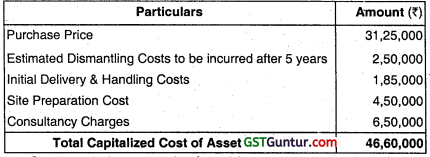
Question 46.
Neon Enterprise operates a major chain of restaurants located in different cities. The company has acquired a new restaurant located at Chandigarh. The new restaurant requires significant renovation expenditure. Management expects that the renovations will last for 3 months during which the restaurant will be closed.
Management has prepared the following budget for this period —
Salaries of the staff engaged in preparation of restaurant before its opening : ₹ 7,50,000
Construction arid remodelling cost of restaurant : ₹ 30,00,000
Explain the treatment of these expenditures as per the provisions of AS 10 Property, Plant and Equipment”. (Nov 2018, 5 marks)
Answer:
As per provisions of AS 10, any cost directly attributable to bring the assets to the location and conditions necessary for it to be capable of operating in the manner indicated by the management are called directly attributable costs and would be included ¡n the costs of an item of PPE.
Management should capitalise the costs of construction and remodeling the restaurants, because they are necessary to bring the store to the condition necessary for it to be capable of operating in the manner intended by management. The restaurant cannot be opened without incurring the remodeling expenditure and thus the expenditure should be considered part of the asset. So, construction and remodeling cost of restaurant of ₹ 30,00,000 should be capitalised.
However, if the cost of salaries, utilities and storage of goods are in the nature of operating expenditure that would be incurred if the restaurant was open, then these costs are not necessary to bring the store to the condition necessary for it to be capable of operating in the manner intended by management should be expensed. So, salaries of the stall engaged in preparation of restaurant before its opening shall not be capitalised (₹ 7,50,000).
Question 47.
Answer the following question:
A Ltd. had following assets. Calculate depreciation for the year ending 31st March, 2020 for each asset as per AS 10 (Revised)
(i) Machinery purchased for ₹ 10 lakhs on 1st April, 2015 and residual value after useful life 0f 5 years, based on 2015 prices is ₹ 10 lakhs.
(ii) Land for ₹ 50 lakhs.
(iii) A Machinery is constructed for ₹ 5,00,000 for its own use (useful life is 10 years). Construction is completed on 1st April, 2019, but the company does not begin using the machine until 31st March. 2020.
(iv) Machinery purchased on 1st April, 2017 for ₹ 50,000 with useful life of 5 years and residual value is NIL. On 1st April 2019, management decided to use this asset for further 2 years only. (Nov 2020, 5 marks)
Question 48.
Preet Ltd. is installing a new plant at its production facility. It has incurred these costs:
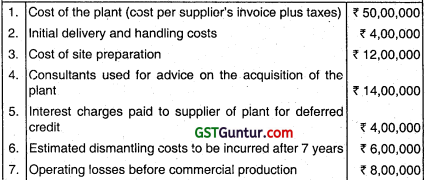
Please advise Preet Ltd. on the costs that can be capitalised in accord with AS 10 (Revised).
Answer:
According to AS 10 (Revised), these costs can be capitailsed:


Note: Interest charges paid on Deferred credit terms” to the supplier of the plant (not a qualifying asset) of ₹ 4,00,000 and operating losses before commercial production amounting to ₹ 8,00,000 are not regarded as directly
attributable costs and thus cannot be capitalised. They should be written off to the Statement of Profit and Loss In the period they are incurred.
Question 49.
Explain “monetary Item” as per Accounting Standard 11. How are foreign currency monetary items to be recognized at each Balance Sheet date?
Classify the follôwing as monetary or non-monetary item:
(i) Share Capital
(ii) Trade Receivables
(iii) Investments
(iv) Fixed Assets (May 2013, 4 marks) (IPCC Gr. II)
Answer
According to AS 11 ‘The Effects of Changes in Foreign Exchange Rates, Monetary items are money held and assets and liablities to be received or paid in fixed or determinable amounts of money.
Foreign currency monetary items should be reported using the closing rate at each balance sheet date.
Whereas, in certain circumstances, the closing rate may not reflect with reasonable accuracy the amount in reporting currency that is likely to be realised from, or required to disburse, a foreign currency monetary item at the balance sheet date.
In such situation, the relevant monetary item should be reported in the reporting currency at the amount which is likely to be realised from or required to disburse, such item at the balance sheet date.

Question 50.
With reference to AS 11, define the following:
(i) Integral Foreign Operation.
(ii) Non-Integral Foreign Operation. (Nov 2016, 4 marks) [IPCC Gr. II]
Answer:
(i) integral Foreign Operation:
It is a foreign operation, the activities of which are an integral part of those of the reporting enterprise a foreign operation that is integral to the operations of the reporting enterprise carries on its business as if it were an extension of the reporting enterprise’s operation.
(ii) Non-Integral Foreign Operation:
It is a foreign operation that is not an integral foreign operation when there is a change between in the exchange rate between the reporting currency and the local currency. There is a little or no direct impact of the present and future cash flow from operations of either the non-integral foreign operation or the reporting enterprise the change in the exchange rate affects the reporting enterprise’s net investment in the non-integral foreign operation rather than the individual monetary and non-monetary Items held by the non-integral foreign operation.
Question 51.
: Exchange Rate
Goodš purchased on 1.1.2007 of US $ 10,000 : ₹ 45
Exchange rate on 31.3.2007 : ₹ 44
Date of actual payment 7.7.2007 : ₹ 43
Ascertain the loss/gain for financial years 2006-07 and 2007-08, also give their treatment as per AS-11. (Nov 2008, 4 marks) (IPCC Gr. II)
Answer:
Provision:
As per AS – 11 all foreign currency transaction should be recorded by applying the exchange rate at the date of transaction.
Analysis and Conclusion:
Therefore, goods purchased on 1.1.2007 and corresponding creditor would
be recorded at ₹ 45 = U$ 1. i.e; 10,000 × 45 = 4,50,000
As per AS 11 at the Balance Sheet date all monetary items should be reported using closing rate, therefore of US$ 10,000 outstanding on 31-3-2007 will be reported = 10,000 × 44 = 4,40,000.
Exchange Loss’Gain (4,40,000 – 4,50,000) = 10,000 Gain should be credited in P/L A/c for 2006-07.
As per AS-11, exchange difference on settlement on maturity items should be transferred to Profit and Loss A/c as gain or loss. Therefore 10,000 × 43 = 4,30,000 – 4,40,000 = ₹ 10,000 gain should be transferred to profit and loss for the year 2007 – 08.
Question 52.
Sterling Ltd. purchased a plant for US $ 20,000 on 31st December, 07 payable after 4 months. The company entered into a forward contract for 4 months @ ₹ 48.85 per dollar. On 31st December, 07, the exchange rate was ₹ 47.50 per dollar.
How will you recognise the profit or loss on forward contract in the books of Sterling Limited for the year ended 31st March, 2008. (Nov 2009, 2 marks) (IPCC Gr. II)
Answer:
Calculation of profit or loss to be recognised In the books of Sterling Limited:

Balance loss of ₹ 6750 (i.e. ₹ 27,000 — ₹ 20,250) for the month of April, 2008 will be recognised in the financial year 2008 – 2009.
![]()
Question 53.
Sunshine Company Limited imported raw materials worth US Dollars 9,000 on 25th February, 2011, when the exchange rate was ₹ 44 per US Dollar. The transaction was recorded in the books at the above mentioned rate. The payment for the transaction was made on 10th April, 2011, when the exchange rate was ₹ 48 per US Dollar. At the year end 31st March, 2011, the rate of exchange was ₹ 49 per US Dollar.
The Chief Accountant of company passed an entry on 31st March, 2011 adjusting the cost of raw material consumed for the difference between ₹ 48 and f 44 per US Dollar. Discuss whether this treatment is justified as per the provisions of AS-11 (Revised). (Nov 2011, 4 marks) [IPCC Gr. II]
Answer:
Provision:
As per para 9 of AS 11, ‘The Effects of Changes in Foreign Exchange Rates’, initial recognition of a foreign currency transaction is done in the reporting currency by applying the exchange rate at the date of the transaction.
Analysis and Conclusion:
Accordingly, on 25th February 2011, the raw material purchased and its creditors will be recorded at US dollar 9,000 × ₹ 44 = ₹ 3,96,000.
Also, as per para 11 of the standard, on balance sheet date such transaction is reported at closing rate of exchange, hence it will be valued at the closing rate i.e. ₹ 49 per US dollar (USD 9,000 × ₹ 49 = ₹ 4,41,000) at 31st March, 2011, irrespective of the payment made for the same subsequently at lower rate in the next financial year.
The difference of ₹ 5 (49 – 44) per US dollar i.e. ₹ 45,000 (USD 9,000 × ₹ 5) will be shown as an exchange loss in the profit and loss account for the year ended 31st March, 2011 and will not be adjusted against the cost of raw materials.
In the subsequent year on settlement date, the company would recognize or provide the Profit and Loss Account an exchange gain of ₹ 1 per US dollar, i.e. the difference from balance sheet date to the date of settlement between ₹ 49 and ₹ 48 per US dollar i.e. ₹ 9,000. Hence, the accounting treatment adopted by the Chief Accountant of the company is incorrect i.e. it is not in accordance with the provisions of AS 11.
Question 54.
Beekay Ltd. purchased fixed assets costing to ₹ 5,000 lakh on 01.04.2012 payable in foreign currency (US $) on 05.04.2013. Exchange rate of 1 US $ = ₹ 50.00 and ₹ 54.98 as on 01.04.2012 and 31.03.2013 respectively.
The company also obtained a soft loan of US$ 1 lakh on 01.04.2012 payable in three annual equal instalments. First instalment was due on 01.05.2013. You are required to state, how these transactions would be accounted for in the books of accounts ending 31st March, 2013. (Nov 2013, 5 marks) [IPCC Gr. II]
Answer:
As per AS -11
(i) Difference arising on reporting of long-term foreign currency monetary items at rates different from those at which they were initially recorded during the period, or reported in previous financial statements, in so far as they relate to requisition of depreciable capital asset, can be added to or deducted from cost of asset.
(ii) The MCA has given an option to capitalize the exchange differences arising on reporting of long term foreign currency monetary items till 31st March, 2020.
Thus the company can capitalize the exchange differences arising due to long term loans linked with the acquisition of fixed assets.
1. Calculation of exchange difference on fixed assets
Foreign Exchange Liability = \(\frac{5,000}{50}\) = US $ 100 lakhs
Exchange Difference = US $ 100 lakhs × (₹ 54.98 – ₹ 50) = ₹ 498 lakhs.
Loss due to exchange difference amounting ₹ 498 lakhs will be capitalised and added in the carrying value of fixed assets. Depreciation on the unamortised amount will be provided in the remaining years.
2. Soft loan exchange difference (US $ 1 lakh i.e. ₹ 50 lakhs)
Value of loan 31.3.13 → US $ 1 lakh × 54.98 = ₹ 54,98,000
Now, AS -11 also provides that in case of liability such as longterm foreign currency monetary item, the exchange difference is to be accumulated in the Foreign Currency Monetary Item Translation Difference (FCMITD) and should be written off over the useful life of such long-term liability, by recognition as income or expenses in each of such periods.
Thus, Exchange difference between reporting currency (INR) and foreign currency (USD) as on 31.03.2013 = US $ 1.00 lakh × ₹ (54.98 – 50) = ₹ 4.98 lakhs.
Loan account is to be increased to 54.98 lakhs and FCMITD account is to be debited by 4.98 lakhs. Since loan is repayable in 3 equal annual instalments, ₹ 4.98 lakhs/3 = ₹ 1.66 lakhs is to be charged in Profit and Loss Account for the year ended 31st March, 2013 and balance in FCMITD A/c ₹ (4.98 lakhs – 1.66 lakhs) = ₹ 3.32 lakhs is to be shown on the ‘Equity & Liabilities’ side of the Balance Sheet as a negative figure under the head ‘Reserve and Surplus’ as a separate line item.
Question 55.
Stem Ltd. purchased a Plant for US$ 30,000 on 30th November, 2013 payable after 6 months. The company entered into a forward contract for 6 months @ ₹ 62.15 per dollar. On 30th November, 2013, the exchange rate was ₹ 60.75 per dollar.
How will you recognise the profit or loss on forward contract in the books of Stem Ltd. for the year ended 31st March, 2014? (Nov 2014, 5 marks) [IPCC Gr. II]
Answer:
Calculation of Profit or Loss
- Value at the rate prevailing at the inception of forward contract
= (USD ₹ 30,000 × 60.75) = ₹ 18,22,500 - Value at forward rate = (USD 30,000 × 62.15) = ₹ 18,64,500
- Total loss on entering into the forward contract = arising at inception for 6 months contract period = ₹ 42,000 (i.e. ₹ 18,64,500 – ₹ 18,22,500)
- Loss to be recognised for the year ended 31st March, 2014
= 42,000 × \(\frac{4}{6}\) = ₹ 28,000
Question 56.
Explain briefly the accounting treatment needed in the following cases as per AS 11 as on 31.3.2015.
Sundry Debtors include amount receivable from Umesh ₹ 5,00,000 recorded at the prevailing exchange rate on the date of sales, transactions recorded at US $ 1 = ₹ 58.50.
Long term loan taken from a U.S. Company, amounting to ₹ 60,00,000. It was recorded at US $ 1 = ₹ 55.60, taking exchange rate prevailing at the date of transaction.
US$ 1 = ₹ 61.20 on 31.3.2015 (Nov 2015, 5 marks) [IPCC Gr. II]
Answer:
As per AS -11 “Accounting for Foreign Exchange transaction on initial recognition should be recorded by applying the foreign currency at the date of the transaction.
But the transaction as on the balance sheet date should be recorded as follows:
Monetary Items: Monetary items are money held and assets and liabilities to be received or paid in fixed or determinable amounts of money. So that the monetary items as on balance sheet date should be reported by using the closing exchange rates.
Non – Monetary items: Non-Monetary items are other than monetary items. Such items which are carried in terms of historical cost denominated in a foreign currency should be reported using the exchange rate at the date of the transaction:
(i) Here the sundry debtors which include the receivable from Umesh ₹ 5,00,000 to be recorded initially by applying exchange rate as on the date of transaction. As on balance sheet date this receivable recorded as rate on the 31 /3/2015 i.e. ₹ 61.20 as it is monetary item as per AS 11. And such difference of rate i.e. (61.20 – 58.50) = 2.7 × 8,547 = ₹ 23,077 is to be credited to P&L A/c as foreign exchange gain.
(ii) In this case firstly loan from US Company recorded at rate of initial recognition ₹ 55.60. On the balance sheet date the rate is ₹ 61.20 so that the loss on the exchange transaction i.e. (61.20 – 55.60) = ₹ 5.6 × 1,07,914 = ₹ 6,04,317. So that loss of ₹ 6,04,317 is to be debited to foreign exchange account and the loan is recorded in B/S at ₹ 55-60.
Question 57.
Shan Builders Limited has borrowed a sum of US $ 10,00,000 at the beginning of Financial Year 2014-15 for its residential project at LIBOR + 3%. The interest is payable at the end of the Financial Year. At the time of availment, exchange rate was ₹ 56 per US $ and the rate as on 31st March, 2015 was ₹ 62 per US $. If Shan Builders Limited borrowed the loan in India in Indian Rupee equivalent, the pricing of loan would have been 10.50%. Compute Borrowing Cost and exchange difference for the year ending 31st March, 2015 as per applicable Accounting Standards. (Applicable LIBOR is 1%). (Nov 2015, 5 marks) [IPCC Gr. II]
Answer:
- Interest for the period 2014-15
= US$ 10 lakhs × 4% × ₹ 62 per US$ = ₹ 24.80 lakhs - Increase in the liability towards the principal amount = US $ 10 lakhs × ₹ (62- 56) = ₹ 60 lakhs
- Interest that would have resulted if the loan was-taken in Indian currency
= US$ 10 lakhs × ₹ 56 × 10.5% = ₹ 58.80 lakhs - Difference between interest on local currency borrowing and foreign currency borrowing = ₹ 58.80 lakhs – ₹ 24.80 lakhs = ₹ 34 lakhs.
Therefore, out of ₹ 60 lakhs increase in the liability towards principal amount, only ₹ 34 lakhs will be considered as the borrowing cost. Thus, total borrowing cost would be ₹ 58.80 lakhs being the aggregate of interest of ₹ 24.80 lakhs on foreign currency borrowings plus the exchange difference to the extent of difference between interest on local currency borrowing and interest on foreign currency borrowing of ₹ 34 lakhs.
Hence, ₹ 58.80 lakhs would be considered as the borrowing cost to be accounted for as per AS 16 “Borrowing Costs” and the remaining ₹ 26 lakhs (60 – 34) would be considered as the exchange difference to be accounted for as per AS 11 “The Effects of Changes in Foreign Exchange Rates”.
Question 58.
M/s Power Track Ltd. purchased a plant for US $ 50,000 on 31st October, 2015 payable after 6 months. The company entered into a forward contract for 6 months @ ₹ 64.25 per Dollar. On 31st October, 2015 the exchange rate was ₹ 61.50 per Dollar.
You are required to recognise the profit or loss on forward contract in the books of the company for the year ended 31st March, 2016. (May 2016, 5 marks) [IPCC Gr. II]
Answer:
Calculation of Profit or Loss to be charged or recognised in the books of M/s Power Track Ltd.
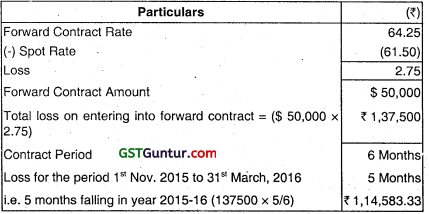
Thus, the loss amounting to ₹ 1,14,583 for the period is to be recognized in the year ended 31st March, 2016.
Question 59.
ABC Ltd. borrowed US $ 5,00,000 on 01/01/2017, which was repaid as on 31/07/2017. ABC Ltd. prepares financial statement ending on 31 /03/2017. Rate of Exchange between reporting currency (INR) and foreign currency (USD) on different dates are as under:
01/01/2017 1 US $ = ₹ 68.50
31/03/2017 1 US $ = ₹ 69.50
31/07/2017 1 US $ = ₹ 70.00
You are required to pass necessary journal entries in the books of ABC Ltd. as per AS 11. (May 2018, 5 marks)
Answer:
Journal Entries in the books of ABC Ltd.
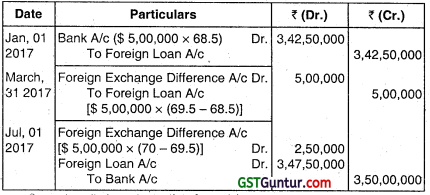
Question 60.
(i) ABC Ltd. a Indian Company obtained long term loan from WWW private Ltd., a U.S. company amounting to ₹ 30,00,000. It was recorded at US $1 = ₹ 60.00, taking exchange rate prevailing at the date of transaction. The exchange rate on balance sheet date (31.03.2018) was US $ 1 = ₹ 62.00.
(ii) Trade receivable includes amount receivable from Preksha Ltd., ₹ 10,00,000 recorded at the prevailing exchange rate on the date of sales, transaction recorded at US $1 = ₹ 59.00. The exchange rate on balance sheet date (31.03.2018) was US $ 1 = ₹ 62.00.
You are required to calculate the amount of exchange difference and also explain the accounting treatment needed in the above two cases as per AS 11 in the books of ABC Ltd. (Nov 2018, 5 marks)
Answer:
As per AS 11 “The effects of changes in Foreign Exchange Rates”, exchange differences arising on the settlement of monetary items or on reporting an enterprise’s monetary items at rates different from those at which they were initially recorded during the period, or reported in previous financial statements, should be recognised as income or as expenses in the period in which they arise.
However, at the option of an entity, exchange differences arising on operating of long-term foreign currency monetary items at rates different from those at which they were initially recorded during the period, or reported in previous financial statements, in so far as they relate to the acquisition of a non-depreciable capital asset can be accumulated in a “Foreign Currency Monetary Item Translation Difference Account” in the enterprises’s financial statements and amortised over the balance period of such long-term asset/liability, by recognition as income or expense in each of such periods.
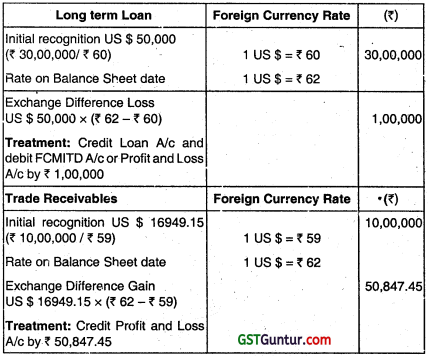
Thus, Exchange Difference on Long term loan amounting ₹ 1,00,000 may either be charged to Profit and Loss A/c or to Foreign Currency Monetary Item Translation Difference Account but exchange difference on trade receivables amounting ₹ 50,847.45 is transferred to Profit & Loss A/c.
Question 61.
AXE Limited purchased fixed assets costing $ 5,00,000 on 1st Jan. 2018 from an American company IWs M&M Limited. The amount was payable after 6 months. The company entered into a forward contract on 1st January 2018 for five months @ ₹ 62.50 per dollar. The exchange rate per dollar was as follows:
On 1st January, 2018 : ₹ 60.75 per dollar
On 31st March, 2018 : ₹ 63.00 per dollar
You are required to state how the profit or loss on forward contract would be recognized in the books of AXE Limited for the year ending 2017-18, as per the provisions of AS 11. (Nov 2018, 5 marks)
Answer:
As per Para 39 of AS 11 ‘Changes in Foreign Exchange Rates’, in recording a forward exchange contract intended for trading or speculation purpose, the premium or discount on the contract is ignored and at each balance sheet date. the value of contract is marked to its Current market price and gain or loss on the contract is recognised.

3 months fallng in the year 2017-18; therefore loss to be recognized in 2017-18 (8,75,000/5) × 3 = ₹ 5,25,000. Rest ₹ 3,50,000 will be recognized in the following year 2018-19.
![]()
Question 62.
Karan Enterprises having its Head Office in Mangalore Karnataka has a branch in Greenville, USA. Following is the trial balance of Branch as at 31-3-2019:
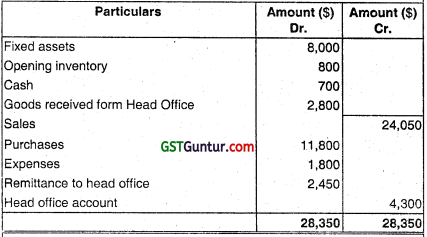
(i) Fixed assets were purchased on 1st April, 2015.
(ii) Depreciation at 10% p.a. s to be charged on fixed assets on straight line method.
(iii) Closing inventory at branch is $ 700 as on 31 -3-2019.
(iv) Goods received form Head Office (HO) were recorded at ₹ 1,85,500 in HO books.
(v) Remittances to HO were recorded at ₹ 1,62,000 in HO books.
(vi) HO account is recorded in HO books at ₹ 2,84,500.
(vii) Exchange rates of US Dollar at different dates can be taken as:
1-4-2015 ₹ 63;
1-4-2018 ₹ 65 and
31-3-2019 ₹ 67.
Prepare the trial balance after been converted into Indian rupees in accordance with AS-11. (Nov 2019, 5 marks)
Answer:
Trial Balance of the Foreign Branch converted into Indian Rupees as on March 31, 2019:
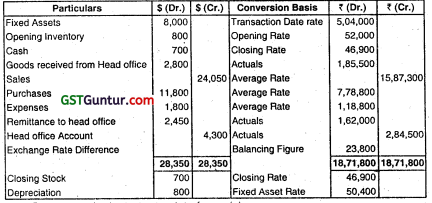
Question 63.
‘Answer the following:
Explain briefly the accounting treatment needed in the following cases as per AS 11 as on 31.03.2020.
(i) Debtors include amount due from Mr. S ₹ 9,00,000 recorded at the prevailing exchange rate on the date of sales, transaction recorded
at US S 1 = ₹ 72.00
US $ 1 = ₹ 73.50 on 31st March, 2020
US $ 1 = ₹ 72.50 on 1st April, 2019
(ii) Long term loan taken on 1st April, 2019 from a U.S. company amounting to ₹ 75,00,000. ₹ 500,000 was repaid on 31st December, 2019, recorded at US $ 1 = ₹ 70.50. Interest has been paid as and when debited by the US company.
US$1 = ₹ 73.50 0n 31st March, 2020
US $ 1 = ₹ 72.50 on 1st April, 2019 (Jan 2021, 5 marks)
Question 64.
: Exchange Rate per $
Goods purchased on 1.1.2017 for US $ 15,000 : ₹ 75
Exchange rate on 31.3.2017 : ₹ 74
Date of actual payment 7.7.2017 : ₹ 73
You are required to ascertain the loss/gain for financial years 2016-17 and 2017-18. also give their treatment as per AS 11.
Answer:
As per AS 11 on ‘The Effects of Changes in Foreign Exchange Rates’, all foreign currency transactions should be recorded by applying the exchange rate on the date of transactions. Thus, goods purchased on 1.1.2017 and corresponding Creditor would be recorded at ₹ 11,25,000 (i.e. ₹ 15,000 × ₹ 75)
According to the standard, at the balance sheet date all monetary transactions shoud be reported using the closing rate. Thus, creditors of US $15,000 on 31.3.217 will be reported at 11,10,000 (ie. $15,000 × ₹ 74) and exchange profit of ₹ 15,000 (i.e. 11,25,000 – 11,10,000) should be credited t0 Profit and Loss account in the year 2016-17.
On 7.7.2017, creditors of $15,000 is paid at the rate of ₹ 73. As per AS 11, exchange difference or settlement of the account should also be transferred to Profit and Loss Account. Therefore, ₹ 15,000 (i.e. 11,10,000 – 10,95,000) will be credited to Profit and Loss Account in the year 2017-18.
Question 65.
Rau Ltd. purchased a plant for US$ 1,00,000 on 01st February 2016, payable after three months. Company entered into a forward contract for three months @ ₹ 49.15 per dollar. Exchange rate per dollar on 01st Feb. concessional rates. In these circumstances, it is was ₹ 48.85. How will you recognise the profit or loss on forward contract in the books of Rau Ltd.?
Answer:

Two falling the year 2016-17; therefore loss to be recognised (30,000/3) × 2 = ₹ 20,000. Rest 10,000 will be recognised in the following year.
Question 66.
How Government grant relating to specific fixed asset is treated in the books as per AS-12?
Answer:
As per AS – 12 ‘Accounting for Government Grants’, Government grant relating to specific fixed asset is treated as follows:
1. Government grants related to specific fixed assets should be presented in the balance sheet by showing the grant as deduction from the gross value of the fixed assets concerned in arriving at their book value.
2. When the grant related to a specific fixed asset equal to the whole, or virtually the whole, of the cost of the asset, the asset should be shown in the balance sheet at a nominal value.
3. Alternatively, government grants related to depreciable fixed assets may be treated as deferred income which should recognised in the profit and loss statement on a systematic and rational basis over the useful life of
the asset. i.e. Such grants should be allocated to income over the periods and in the proportions in which depreciation on those assets is charged.
(i) Grant related to non – depreciable assets are credited to capital reserve under this method, as there is usually no charge to income in respect of such assets.
(ii) But, when a grant related to a non – depreciable asset requires the fulfillment of certain obligations, the grant is credited to income over the same period over which the cost of certain obligations, the grant is credited to income over the same period over which the cost of meeting such obligations to charged to income.
(iii) Any differed income is suitably disclosed in the balance sheet pending its apportionment to profit & loss account.
Question 67.
How would you record a non-monetary grant received from the Government as per AS-12? (May 2008, 2 marks) (IPCC Gr. II]
Answer:
Para 7 of AS-12 deals with the accounting treatment of Non-monetary Government Grants which says that Government grants may take the form of non-monetary assets, such as land or other resources, given at concessional rates. In these circumstances, it is usual to account for such assets at their acquisition cost. Non-monetary assets given tree of cost are recorded at a nominal value.
Question 68.
Siva Limited received a grant of ₹ 1,500 lakhs during the last accounting year (2009-10) from Government for welfare activities to be carried on by the company for its employees. The grant prescribed conditions for its utilization. However during the year 2010-11, it was found that the conditions of the grant were not compiled with and the grant had to be refunded to the Government in full. Elucidate the current accounting treatment with reference to the provisions of AS-12. (May 2011, 4 marks) (IPCC Gr. II)
Answer:
According to AS 12 ‘Accounting for Government Grants’, Government Grant may, sometimes, become refundable if certain conditions are not fulfilled.
A government grant that becomes refundable is treated as extra ordinary item as per AS, 5 ‘Net Profit or Loss for the Period, Prior Period items and Changes in Accounting Policies.
The amount refundable in respect of a government grant related to revenue is applied first against any unamortized deferred credit remaining in respect of the grant. To the extent that the amount refundable exceeds any such deferred credit, or where no deferred credit exists, the amount is charged immediately to profit and loss statement.
In the given situation the amount of refund of grant of ₹ 1,500 lakhs should be charged to the profit and loss account in the year 2010-2011 as an extraordinary item.
Question 69.
Explain the treatment of Refund of Government Grants as per Accounting Standard-12. (Nov 2017, 4 marks) (IPCC Gr. II)
OR
Explain in brief the treatment of Refund of Government Grants in line with AS 12 in the following three situations:
(i) When Government Grant is related to revenue.
(ii) When Government Grant is related to specific fixed assets,
(iii) When Government Grant is in the nature of Promoter’s contribution. (May 2014, 4 marks) [IPCC Gr. II]
Answer:
Para 11 of AS 12, “Accounting for Government Grants”, explains treatment of government grants in following situations:
(i) When government grant is related to revenue:
(a) When deferred credit account has a balance: The amount of government grant refundable will be adjusted against unamortized deferred credit balance remaining in respect of the grant. To the extent that the amount refundable exceeds any such deferred credit the amount is immediately charged to profit and loss account.
(b) Where no deferred credit account balance exists: The amount of Government grant refundable will be charged to profit and loss account.
(ii) When government grant is related to specific fixed assets:
(a) Where at the time of receipt the amount of Government grant reduced the cost of asset: The amount of Government grant refundable will increase the book value of the asset.
(b) Where at the time of receipt the amount of government grant was credited to “Deferred Grant Account”: The amount of Government grant refundable will reduce the capital reserve or unamortized balance of deferred grant account as appropriate.
(iii) When Government grant is in the nature of Promoter’s contribution:
The amount of government grant refundable in part or in full on non fulfilment of specific conditions, the relevant amount recoverable by the Government will be reduced from capital reserve.
A Government grant that becomes refundable is treated as an extra ordinary item.
Question 70.
State whether the following statement is True’ or False’. Also give reason for your answer.
2. As per the provisions of AS-12, government grants in the nature of promoters’ contribution which become refundable should be reduced from the capital reserve. (May 2019, 1 mark)
Answer:
This statement is True.
As per AS 12, government grants in the nature of promoters contribution which become refundable should be reduced from the capital reserve.
Question 71.
X Ltd. received a revenue grant of ₹ 10 crores during 2006-07 from Government for welfare activities to be carried on by the company for its employees. The grant prescribed the conditions for utilisation. However during the year 2008-09, it was found that the prescribed conditions were not fulfilled and the grant should be refunded to the Government.
State how this matter will have to be dealt with in the financial statements of X Ltd. for the yew ended 2008-09. (2 marks) [IPCC Gr. II]
Answer:
Provision:
Acccording to AS 12 “Accounting for Government Grants”, a grant that became refundable should be treated as an extra-ordinary item as per Accounting Standard 5 Net Profit or Loss for the Period, Prior Period Items and Changes in Accounting Policies. The amount refundable in respect of a government grant related to revenue, is applied first against any unamortised deferred credit remaining in respect of the grant. To the extent that the amount refundable exceeds any such deferred credit, or where no deferred credit exists, the amount is charged Immediately to profit and loss statement.
Analysis and Conclusion:
Therefore, refund of grant of ₹ 10 crores should be shown in the profit and loss account of the company as an extra-ordinary item during the financial year 2008-09.
![]()
Question 72.
Santosh Ltd. has received a grant of ₹ 8 crores from the Govt. for setting up a factory in a backward area. Out of this grant, the company distributed ₹ 2 crores as dividend. Also, Santosh Ltd. received land free of cost from the State Government but it has not recorded it at all in the books as no money has been spent. In the light of AS 12, examine, whether the treatment of both the grants is correct. (May 2010, 2 marks) (IPCC Gr. II]
Answer:
Provision and Analysis:
According to AS-12 ‘Accounting for Government Grants’, when government grant is received for a specific purpose, it should be utilised for the same. Therefore, the grant received for setting up a factory is not available for distribution of dividend.
In the second case, even if the company has not spent money for the acquisition of land, land should be recorded in the books of accounts at a nominal value.
Conclusion:
The treatment of both the grants is incorrect according to AS-12.
Question 73.
ABC Limited purchased a machinery for ₹ 25,00,000 which has estimated useful life of 10 years with the salvage value of ₹ 5,00,000. On purchase of the assets Central Government pays a grant for ₹ 5,00,000. Pass the journal entries with narrations In the books of the company for the first year, treating grant as deferred income. (May 2012, 5 marks) (IPCC Gr. II)
Answer:
Journal Entries in the Books of ABC Ltd.
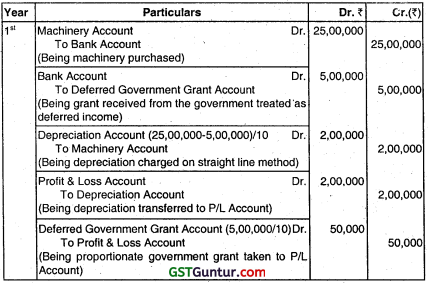
Question 74.
M/s. A Ltd. has set up its business In a designated backward area with an investment of ₹ 200 lakhs. The Company is eligible for 25% subsidy and has received ₹ 50 lakhs from the Government.
Explain the treatment of the Capital Subsidy received from the Government in the Books of the company. (May 2015, 4 marks) (IPCC Gr. II)
Answer:
As per AS-12, Accounting for Government Grants, the grant or subsidy received from government is recognised only when there is reasonable assurance that the enterprise will comply with conditions attached to them and the grants will be received.
Here, the company has been set up in backward area and eligible to receive the capital Subsidy and it has received the subsidy so that ₹ 50 lakhs shall be recognised in books of the company.
₹ 50 lakhs shall be recognised as Capital Reserve and to be written off over a period of time as expenditure incurred.
Question 75.
M/s ABC Ltd. purchased fixed assets for ₹ 50,00,000. Government grant received towards it is 20%. Residual value is ₹ 8,00,000 and useful life is 8 years. Assumed depreciation is on the basis of Straight Line Method.
Asset is shown in the Balance Sheet net of grant. After one year, grant becomes refundable to the extent of ₹ 7,00,000 due to non-compliance of certain conditions.
Pass Journal entries for 2nd year in the books of the companý. (May 2016, 5 marks) (IPCC Gr. II)
Answer:
Journal Entries in the books of ABC Ltd. for 2nd year
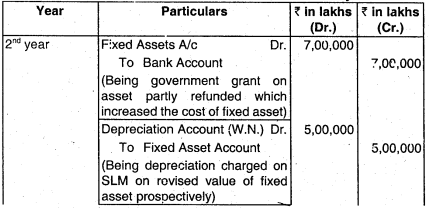

Working Note:
Depreciation for year 2
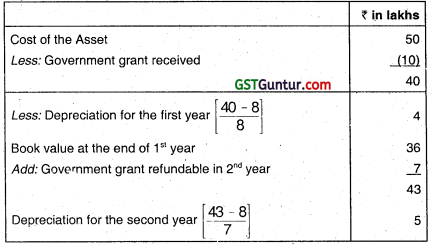
Question 76.
Ram Ltd. purchased machinery for ₹ 80 lakhs. (useful life 4 years and residual value ₹ 8 lakhs). Government grant received is ₹ 32 lakhs. Show the Journal Entry to be passed at the time of refund of grant and the value of the fixed assets in the third year and the amount of depreciation for remaining two years, if
(i) the grant is credited to Fixed Assets A/c.
(ii) the grant is credited to Deterred Grant A/c. (May 2007, 5 marks)
Answer:
In the books of Ram Ltd. Journal Entries
(At the time of refund of grant)
(i) if Grant is credited to Fixed Asset A/c:

(ii) The Balance of Fixed Asset in the 3rd Year:
Fixed Asset initially recorded = 80 L – 32 L
= 48 L
Depreciation p.a. = \(\left(\frac{48,00,000-8,00,000}{4 \text { years }}\right)\) = ₹ 10,00,000 p.a.
1, 4years )
Value of Fixed Asset after 2 years but before
refund = 48,00,000 — (10,00,000 × 2) = ₹ 28,00,000
Value of Fixed Asset after refund
= ₹ 28,00,000 + 32,00,000
= ₹ 60,00,000
(iii) The amount of depreciation for remaining 2 years:
= \(\left(\frac{60,00,000-8,00,000}{2 \text { years }}\right)\) = ₹ 26,00,000 p.a.
If the grant is credited to Deferred Grant Account:
As per AS 12 ‘Accounting for Government Grants,’ income from Deferred Grant Account is allocated to Profit and Loss Account usually over the periods and in the proportions in which depreciation on related assets is charged.
Accordingly, in the first two years (₹ 32 lakhs /4 years) = ₹ 8 lakhs pa. × 2 years = ₹ 16 lakhs will be credited to Profit and Loss Account and ₹ 16 lakhs will be the balance of Deferred Grant Account after two years.
Therefore, on refund of grant, following entry will be passed:

1. Value of Fixed Assets after two years but before refund of grant:
Fixed assets initially recorded k the books = ₹ 80 lakhs
Depreciation p.a. = (₹ 80 lakhs – ₹ 8 lakhs)/4 years = ₹ 18 lakhs per year
Book value of fixed assets after two years = ₹ 80 lakhs – (₹ 18 lakhs × 2 years) = 44 Lakhs
2. Value of Fixed Assets after refund of grant:
On refund of grant the balance of deterred grant account will become Nil. The Fixed assets will continue to be shown in the books at ₹ 44 Lakhs.
3. Amount of depreciation for remaining two years:
Depreciation will continue to be charged at ₹ 18 Lakhs per annum for the remaining two years.
Question 77.
On 01.04.2014, XYZ Ltd. received Government grant of ₹ 100 Lakhs for an acquisition of new machinery costing ₹ 500 Lakhs. The grant was received and credited to the cost of the asset. The life span of the machinery is 5 years. The machinery is depreciated at 20% on WDV method. The company had to refund the entire grant in 2nd April, 2017 due to non-fulfilment of certain conditions which was imposed by the government at the time of approval of grant.
How do you deal with the refund of grant to the government in the books of XYZ Ltd., as per AS 12? (May 2018, 5 marks)
Answer:
According to para 21 of AS 12 on Accounting for Government Grant, the amount refundable in respect of a grant related to a specific fixed asset should be recorded by increasing the book value of the asset or by reducing deferred income balance, as appropriate, by the amount refundable. Where the book value is increased depreciation on the revised book value should be provided prospectively over the residual useful life of the asset.

Depreciation @ 20% on the revised book value amounting ₹ 304.80 Lakhs is to be provided prospectively over the residual useful life of the asset.
Question 78.
Answer the following question:
On 1st April, 2016, Mac Ltd. received a Government Grant of ₹ 60 lakhs for acquisition of machinery costing ₹ 300 lakhs. The grant was credited to the cost of the asset. The estimated useful life of the machinery is 10 years. The machinery is depreciated @ 10% on WDV basis. The company had to refund the grant in June 2019 due to non-compliance of certain conditions. How the refund of the grant is dealt with in the books of Mac Ltd. assuming that the company did not charge any depreciation for the year 2019-20. Pass necessary Journal Entries for the year 2019-20. (Nov 2020, 5 marks)
Question 79.
Answer the following:
Darshan Ltd. purchased a Machinery on 1st April, 2016 for ₹ 130 lakhs (Useful life is 4 years). Government grant received is ₹ 40 lakhs for the purchase of above Machinery.
Salvage value at the end of useful life is estimated at ₹ 60 lakhs.
Darshan Ltd. decides to treat the grant as deferred income.
You are required to calculate the amount of depreciation and grant to be recognised in profit & loss account for the year ending 31st March, 2017, 31st March, 2018, 31st March, 2019 & 31st March, 2020.
Darshan Ltd. follows straight line method for charging depreciation. (Jan 2021, 5 marks)
Question 80.
A specific government grant of ₹ 15 lakhs was received by USB Ltd. for acquiring the Hi-Tech Diary plant of ₹ 95 lakhs during the year 2014-15. Plant has useful life of 10 years. The grant received was credited to deferred income in the balance sheet. During 2017-18, due to non- compliance of conditions laid down for the grant, the company had to refund the whole grant to the Government. Balance in the deferred income on that date was ₹ 10.50 lakhs and written down value of plant was ₹ 66.50 lakhs.
(i) What should be the treatment of the refund of the grant and the effect on cost of plant and the amount of depreciation to be charged during the year 2017 -18 in profit and loss account?
(ii) What should be the treatment of the refund, if grant was deducted from the cost of the plant during 2014-15 assuming plant account showed the balance of ₹ 56 lakhs as on 1.4.2017?
You are required to explain in the line with provisions of AS 12.
Answer:
As per para 21 of AS 12, ‘Accounting for Government Grants’, “the amount refundable in respect of a grant related to specific fixed asset should be recorded by reducing the deferred income balance. To the extent the amount refundable exceeds any such deferred credit, the amount should be charged to profit and loss statement.
(i) In this case the grant refunded is ₹ 15 lakhs and balance in deferred income is ₹ 10.50 lakhs, ₹ 4.50 lakhs shall be charged to the profit and loss account for the year 2017-18. There will be no effect on the cost of the fixed asset and depreciation charged will be on the same basis as charged in the earlier years.
(ii) If the grant was deducted from the cost of the plant in the year 2014-15 then, para 21 of AS 12 states that the amount refundable in respect of grant which relates to specific fixed assets should be recorded by increasing the book value of the assets, by the amount refundable.
Where the book value of the asset is increased, depreciation on the revised book value should be provided prospectively over the residual useful life of the asset. Therefore, in this case, the book value of the plant shall be increased by ₹ 15 lakhs. The increased cost of ₹ 15 lakhs of the plant should be amortized over 7 years (residual life). Depreciation charged during the year 2017-18 shall be (56+15)/7 years = ₹ 10.14 lakhs presuming the depreciation is charged on SLM.
![]()
Question 81.
Paridhi Electronics Ltd. has current investment (X Ltd.s shares) purchased for ₹ 5 lakhs, which the company want to reclassify as long term investment on 31.3.2018. The market value of these investments as on date of Balance Sheet was ₹ 2.5 lakhs. How will you deal with this as on 31.3.18 with reference to AS-13?
Answer:
As per AS 13 ‘Accounting for Investments’, where investments are reclassified from current to long-term, transfers are made at the lower of cost or fair value at the date of transfer.
In the given case, the market value of the investment (X Ltd. shares) is 2.50 lakhs, which is lower than its cost i.e. ₹ 5 lakhs. Therefore, the transfer to long term investments should be made at cost of ₹ 2.50 lakhs. The loss of. ₹ 2.50 lakhs should be charged to profit and loss account.
Question 82.
Mention two categories of investments defined by AS 13 and also State their valuation principles. (Nov 2008, 2 marks)
Answer:
As per AS 13 ‘Accounting for Investments’, there are two categories of investments, viz. Current Investments and Long Term Investments.
According to Para 14 of the standard, the carrying amount for Current Investments is the lower of cost and fair value whereas Long Terms Investments are valued at cost less permanent diminutions in value of investment. For current investments, according to this standard any reduction to fair value and any reversals of such reductions are included in the profit and loss statement.
Question 83.
State whether the following statement is ‘True’ or-False’. Also give reason for your answer.
4. As per the provisions of AS-13, a current investments is an investment that is by its nature is readily realisable and is intended to be held for not more than six months from the date on which such investment is made. (May 2019, 1 mark)
Answer:
This statement is False
As per AS 13, a current investment is an investment that is by its nature readily realisable and is intended to be held for not more than one year from the date on which such investment is made.
Question 84.
M/s Innovative Garments Manufacturing Company Limited invested in the shares of another company on 1st October, 2011 at a cost of ₹ 2,50,000. It also earlier purchased Gold of ₹ 4,00,000 and Silver of ₹ 2,00,000 on 1st March, 2009. Market value as on 31st March, 2012 of above investments are as follows:
Shares : ₹ 2,25,000
Gold : ₹ 6,00,000
Silver : ₹ 3,50,000
How above investments will be shown in the books of accounts of M/s Innovative Garments Manufacturing Company Limited for the year ending 31st March, 2012 as per the provisions of Accounting Standard 13 “Accounting for Investments”? (May 2012, 5 marks)
Answer:
Provision:
According to AS-13, Accounting for Investments, for investment in shares:
- If shares are purchased with an intention to hold for short-term period then it will be shown at the realizable value of ₹ 2,25,000 as on 31st March, 2012.
- However, if equity shares are acquired with an intention to hold for long term period then it will be shown at cost of ₹ 2,50,000 in the Balance Sheet of the company.
- However, provision for diminution shall be made to recognize a decline, if other than temporary, in the value of shares.
- According to the standard, investment acquired for long term period shall be shown at cost. Gold and silver are generally purchased with an intention to hold it for long term period until and unless given otherwise.
Analysis and Conclusion:
The investment in Gold and Silver (purchased on 1st March, 2009) shall continue to be shown at cost as on 31st March, 2012 i.e., ₹ 4,00,000 and ₹ 2,00,000 respectively, though their realizable values have increased.
Question 85.
Blue-chip Equity Investments Ltd., wants to re-classify its investments in accordance with AS-13.
(i) Long term investments in Company A, costing ₹ 8.5 lakhs are to be re-classified as current. The company had reduced the value of these investments to ₹ 6.5 lakhs to recognize a permanent decline in value. The fair value on date of transfer is ₹ 6.8 lakhs.
(ii) Long term investments in Company B, costing ₹ 7 lakhs are to be re-classified as current. The fair value on date of transfer is ₹ 8 lakhs and book value is ₹ 7 lakhs.
(iii) Current investment in Company C, costing ₹ 10 lakhs are to be re-classified as long term as the company wants to retain them. The market value on date of transfer is ₹ 12 lakhs.
(iv) Current investment in Company D, costing ₹ 15 lakhs are to be re-classified as long term. The market value on date of transfer is ₹ 14 lakhs. (Nov 2014, 5 marks)
Answer:
(i) As per provisions of AS-13, ‘Accounting for investments’ whenever there is re-classification of investment, as long term investments are re-classified as current investments then transfer are made at lower of cost and carrying amount at the date of transfer.
Here, cost of investment is ₹ 8.5 lakhs and carrying value as on date of transfer is ₹ 6.5 lakhs. Then, investment is valued at ₹ 6.5 lakhs on re-classification.
(ii) As, on re-classification from long term investment to current investment than it is recognised lower of cost and carrying value on transfer date.
Here, long term investment in Company B to be re-classified as current cost of investment is ₹ 7 lakhs and carrying value is ₹ 7 lakhs. Then investment is re-classified as ₹ 7 lakhs which is lower of cost and fair value.
(iii) As per AS-13, when there is re-classification of investment from current to long term investments then valuation is to be done lower of cost and fair value at the date of transfer.
Here, investment in Company C shall be re-classified as long term. The cost of investment is ₹ 10 and fair value on transfer date is ₹ 12 lakhs. Then investment is valued at ₹ 10 lakhs which is lower of cost and fair value.
(iv) As per AS-13, when there is re-classification of investment from current to long term investments then valuation is to be done on lower of cost and fair value at the date of transfer.
Here investment in Company D shall be re-classified as long term. The cost of investment is ₹ 15 lakhs and fair value on transfer date is ₹ 14 lakhs. Then investment is valued of ₹ 14 lakhs which is lower of cost and fair value.
Note: This question states that Blue Chip Equity Investment Ltd. wants to reclassify its investments in accordance with AS 13. The values, at which the investments have to be reclassified, have been given in the above answer.
Question 86.
M/s Active Builders Ltd. invested in the shares of another company on 31st October, 2015 at a cost of ₹ 4,50,000. It also earlier purchased Gold of ₹ 5,00,000 and Silver of ₹ 2,25,000 on 31st March, 2013. Market values as on 31st March, 2016 of the above investments are as follows:
Shares ₹ 3,75,000; Gold ₹ 7,50,000 and Silver ₹ 4,35,000
How will the above investments be shown in the books of account of M/s Active Builders Ltd. for the year ending 31st March, 2016 as per the provision of AS-13? (May 2016, 5 marks)
Answer:
As per AS -13 “Accounting for Investments”, investments Which are for long-term purpose should be carried at cost whereas short-term Investments or current investments should be classified at lower of cost and fair value.
In this case, M/s. Active Builders Ltd. should disclose the investments as below as on 31/03/2016:

Loss in shares should be charged to Profit & Loss Account of ₹ 75,000.
Question 87.
How you will deal with following in the financial statement of the Paridhi Electronics Ltd. as on 31.3.16 with reference to AS-13?
(i) Paridhi Electronics Ltd. invested in the shares of another unlisted company on 1st May, 2012 at a cost of ₹ 3,00,000 with the intention of holding more than a year. The published accounts of unlisted company received in Jan 2016 reveals that the company has incurred cash losses with decline market share and investment of Paridhi Electronics Ltd. may not fetch more than ₹ 45,000.
(ii) Also Paridhi Electronics Ltd. has current investment (X Ltd.’s shares) purchased for ₹ 5 lakhs, which the company wants to reclassify as long term investment. The market value of these investments as on date of Balance Sheet was ₹ 2.5 lakhs. (Nov 2016, 5 marks)
Answer:
(i) Provision:
Any reduction in the carrying amount and any reversal such as reduction should be charged and credited to Profit and Loss A/c.
Analysis:
Paridhi Electronics Ltd. invested in an unlisted company shares of ₹ 3,00,000. There is a decline in market share and investment may not fetch more than ₹ 45,000. The facts of the case clearly indicate that the decline in the value of the Long-Term Investment is not temporary.
Hence, a provision for diminution should be made to reduce the Carrying Amount of Long-Term Investment to ₹ 45,000 in the Financial Statements for the year ended 31.03.2016.
The Published Accounts of the unlisted company provide further evidence as to the conditions persisting at the Balance Sheet date. Hence, this is an “Adjusting Event”under AS-4.
Conclusion:
AS-13 requires disclosure of changes in carrying amounts of long-term investments.
Hence, reduction in carrying amount should be charged to Profit and Loss A/c (i.e.; ₹ 2,55,000).
(ii) Provision:
As per AS-13 ‘Accounting for Investments’, where investments are reclassified from current to long term, transfer are made at lower of cost and fair value on the date of transfer.
Analysis:
In the given case Paridhi Electronics Ltd. has current investment for ₹ 5 lakhs and fair value as on date is ₹ 2.5 lakhs.
Conclusion:
Hence, reclassification will be made at ₹ 2.5 lakhs as market value is less than the cost of ₹ 5 lakhs.
Question 88.
On 15th June, 2018, Y limited wants to re-classify its investments in accordance with AS-13 (revised). Decide and state the amount of transfer, based on the following information:
1. A portion of long term investments purchased on 1st March, 2017 are to be re-classified as current investments. The original cost of these investments was ₹ 14 lakhs but had been written down by ₹ 2 lakhs (to recognise ‘other than temporary’ decline in value). The market value of these investments on 15th June, 2018 was ₹ 11 lakhs.
2. Another portion of long term investments purchased on 15th January, 2017 are to be re-classified as current investments. The original cost of these investments was ₹ 7 lakhs but had been written down to ₹ 5 lakhs (to recognise ‘other than temporary’ decline in value). The fair value of these investments on 15th June, 2018 was ₹ 4.5 lakhs.
3. A portion of current investments purchased on 15th March, 2018 for ₹ 7 lakhs are to be re-classified as long term investments, as the company has decided to retain them. The market value of these investments on 31st March, 2018 was ₹ 6 lakhs and fair value on 15th June, 2018 was ₹ 8.5 lakhs.
Another portion of current investments purchased on 7th December, 2017 for ₹ 4 lakhs are to be re-classified as long term investments. The market value of these investments was:
Answer:
- As per AS 13, (Revised) Accounting for Investment, where long-term investments are reclassified as current investments, transfers are made at the lower of cost and carrying amount at the date of transfer.
- Where investments are reclassified from current to long-term, transfers are made at the lower of cost and fair value at the date of transfers.
1. In the first case, investment is written down by ₹ 2 lakhs as it is other than temporary decline in value. So carrying amount is ₹ 12 lakhs. ₹ 2 lakhs will be charged to P&L A/c. Now this investment is reclassified as current, which will be made at lower cf cost (i.e. 14 lakhs) and carrying amount (i.e. 12 lakhs). Hence, long term investment are reclassified as current investment should be carried at ₹ 12 lakhs.
2. In the second case, investment is written down to ₹ 5 lakhs as it is other than temporary decline in value so carrying amount is ₹ 5 lakhs. ₹ 2 lakhs will be charge to P&L A/c. Now this investment is reclassified as current, so transfer will be made at lower of cost (₹ 7 lakhs) and carrying amount (i.e. 5 lakhs). Hence, long term investment is reclassified as current investment should be carried at ₹ 5 lakhs.
3. In the third case, the fair value on 15th June 2018 was ₹ 8.5 lakhs, which is higher then cost i.e. ₹ 7 lakhs. Therefore the transfer to long term investments should be carried at cost ₹ 7 lakhs.
4. In the forth case, the fair value on 15th June 2018 was ₹ 3.8 lakhs, which is lower than cost i.e. ₹ 4 lakhs. Therefore, the transfer to long term investments should be carried at fair value i.e. ₹ 3.8 lakhs. The loss of ₹ 0.20 lakhs should be charged to P&L A/c.
Question 89.
Answer the following question:
A Limited invested in the shares of XYZ Ltd. on 1st December, 2019 at a cost of ₹ 50,000. Out of these shares ₹ 25,000 shares were purchased with an intention to hold for 6 months and ₹ 25,000 shares were purchased with an intention to hold as long-term Investment.
A Limited also earlier purchased Gold of ₹ 1,00,000 and Silver of ₹ 30,00,000 on 1st April, 2019. Market value as on 31st March, 2020 of above investments are as follows:
Shares ₹ 47,500 (Decline in the value of shares is temporary.)
Gold ₹ 1,80,000
Silver ₹ 30,55,000
How above investments will be shown in the books of accounts of M/s A Limited for the year ending 31st March, 2020 as per the provisions of AS 13 (Revised)? (Nov 2020, 5 marks)
![]()
Question 90.
Answer the following:
Kunal Securities Ltd. wants to reclassify its investments in accordance with AS-13 (Revised). State the values, at which the investments have to be reclassified in the following cases:
(i) Long term investment in Company A, costing ₹ 10.5 lakhs is to be reclassified as current investment. The company had reduced the value of these investments to ₹ 9 lakhs to recognize a permanent decline in value. The fair value on the date of reclassification is ₹ 9.3 lakhs.
(ii) Long term investment in Company B, costing ₹ 14 lakhs is to be re-classified as current investment. The fair value on the date of reclassification is ₹ 16 lakhs and book value is ₹ 14 lakhs.
(iii) Current investment in Company C, costing ₹ 12 lakhs is to be re-classified as long term investment as the company wants to retain them. The market value on the date of reclassification is ₹ 13.5 lakhs.
(iv) Current investment in Company D, costing ₹ 18 lakhs is to be re-classified as long term investment. The market value on the date of reclassification is ₹ 16.5 lakhs. (Jan 2021, 5 marks)
Question 91.
Write short note on ‘Suspension of Capitalisation’ in context of Accounting Standard 16. (May 2016, 4 marks) [IPCC Gr II]
Answer:
Suspension of Capitalisation:
As per AS-16 Borrowing cost is suspension of capitalisation are as follows:
(i) When all activities necessary to prepare the qualifying asset for its intended use or sale are in progress then capitalisation of borrowing costs should continue during the period in which active development is in progress.
(ii) When all the activities necessary to prepare the qualifying asset for its intended use or sale are interrupted then capitalisation of borrowing costs should be suspended during extended periods in which active development is interrupted.
(iii) When all the activities necessary to prepare the qualifying asset for its intended use or sale are complete then capitalisation of borrowing costs should cease completion of active development.
Question 92.
Enumerate two points which the financial statements should disclose in respect of Borrowing costs as per AS-16. (May 2009, 2 marks) [IPCC Gr. II]
Answer:
As per AS 16, the Financial Statements should disclose the following:
- The accounting policy adopted for borrowing costs and
- The amount of borrowing costs capitalized during the period.
Question 93.
Briefly indicate the items which are included in the expressions “Borrowing Cost” as per AS-16. (Nov 2009, 2 marks) [IPCC Gr. II]
Answer:
Borrowing costs are interest and other costs incurred by an enterprise in connection with the borrowing of funds.
Borrowing cost generally includes:
- Interest and commitment charges on bank borrowings and other short term and long term borrowings.
- Amortisation of discounts or premiums relating to borrowings.
- Amortisation of ancillary costs incurred in connection with the arrangement of borrowings.
- Finance charges in respect of assets required under finance leases or under other similar arrangements; and
- Exchange differences arising from foreign currency borrowings to the extent that they are regarded as an adjustment to interest costs.
Question 94.
An industry borrowed ₹ 40,00,000 for purchase of machinery on 1.6.2007. Interest on loan is 9% per annum. The machinery was put to use from 1.1.2008. Pass journal entry for the year ended 31.3.2008 to record the borrowing cost of loan as per AS-16. (May 2008, 2 marks) [IPCC Gr. II]
Provision:
As per AS-16 a qualifying asset is an asset which takes substantial period of time for completion;
Also reference is drawn to Accounting standard Interpretation-1 which states as follows “The issue as to what constitutes a substantial period of time primarily depends on the facts and circumstances of each case. However, ordinarily, a period of twelve months is considered as substantial period of time unless a shorter or longer period can be justified on the basis of facts and circumstances of the case. In estimating the period, time which an asset takes, technologically and commercially, to get it ready for its intended use or sale should be considered.”
Analysis and Conclusion:
In the present question, it is assumed that the asset in question is a qualifying asset. Hence the borrowing cost incurred till the date of asset coming into use will be capitalized.
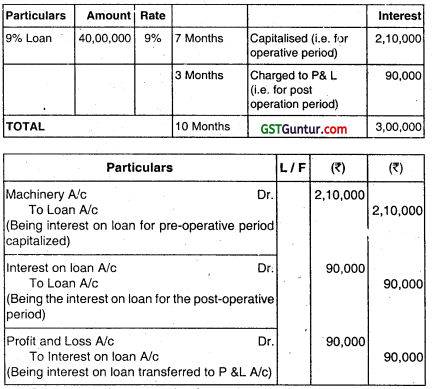
Question 95.
Axe Limited began construction of a new plant on 1st April, 08 and obtained a special loan of ₹ 4,00,000 to finance the construction of the plant. The rate of interest on loan was 10%.
The expenditure that were made on the project of plant were as follows:
1st April : ₹ 5,00,000
1st August, 08 : ₹ 12,00,000
1st January, 09 : ₹ 2,00,000
The company’s other outstanding non-specific loan was ₹ 23,00,000 at an interest rate of 12%.
The construction of the plant completed on 31st March, 09. You are required to:
(a) Calculate the amount of interest to be capitalized as per the provisions of AS-16 “Borrowing cost”.
(b) Pass a journal entry for capitalizing the cost and the borrowing cost in respect of the plant. (Nov 2009, 5 marks) [IPCC Gr. II]
Answer:
Total expenses to be capitalized for borrowings as per AS 16 “Borrowing Costs”:

Working Notes:
1. Computation of average accumulated expenses

2. Amount of interest capitalised

Question 96.
Rohini Limited has obtained loan from an Institution for ₹ 500 lakhs for modernization and renovating its Plant and Machinery. The installation of plant and machinery was completed on 31.3.2009 amounting to ₹ 320 lakhs and ₹ 50 lakhs advanced to suppliers of additional assets and the balance of ₹ 130 lakhs has been utilized for working capital requirements. Total interest paid for the above loan amounted to ₹ 65 lakhs during 2008- 09. You are required to state how the interest on institutional loan is to be accounted for in the year 2008-09. (May 2010, 2 marks) [IPCC Gr. II]
Answer:
Provision:
According to AS 16 ‘Borrowing Costs’, borrowing costs that are directly attributable to the acquisition, construction or production of qualifying assets (Qualifying asset means an asset that necessarily takes substantial period of time to get ready for its intended use or sale.) should be capitalised as part of the cost of that asset. Other borrowing costs are recognized as expense in the period in which they are incurred.
Analysis and Conclusion:
The treatment for total interest amount of ₹ 65 lakhs can be given as:
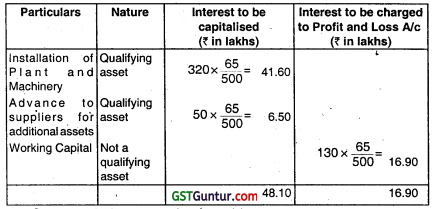
Question 97.
On 1st April 2009 Amazing Construction Ltd. obtained a loan of ₹ 32 crores to be utilized as under:
(i) Construction of sea link across two cities :
(work was held up totally for a month during the year due to high water levels) : ₹ 25 crores
(ii) Purchase of equipments and machineries : ₹ 3 crores
(iii) Working capital : ₹ 2 crores
(iv) Purchase of vehicles : ₹ 50,00,000
(v) Advance for tools/cranes etc. : ₹ 50,00,000
(vi) Purchase of technical know-how : ₹ 1 crores
(vii) Total interest charged by the bank for the year ending 31st March 2010 : ₹ 80,00,000
Show the treatment of interest by Amazing Construction Ltd. (Nov 2010, 4 marks) [IPCC Gr. II]
Answer:
Provision:
As per AS – 16 ‘Borrowing costs’, qualifying asset is an asset that necessarily takes substantial period of time to get ready for its intended use.
Borrowing costs that, are directly attributable to the acquisition, construction or production of a qualifying asset should be capitalised as part of the cost of that asset. Other borrowing costs should be recognised as an expense in the period in which they are incurred. (AS 16 para 6)
Analysis and Conclusion:
The treatment of interest by Amazing Construction Ltd. can be shown

Question 98.
On 1st April 2009 Amazing Construction Ltd. obtained a loan of ₹ 32 crores to be utilized as under:
(i) Construction of sea link across two cities:
(work was held up totally for a month during the year due to high water levels) : ₹ 25 crores
(ii) Purchase of equipments and machineries : ₹ 3 crores
(iii) Working capital : ₹ 2 crores
(iv) Purchase of vehicles : ₹ 50,00000
(v) Advance for tools/cranes etc. : ₹ 50,00000
(vi) Purchase of technical know-how : ₹ 1 çrores
(vii) Total Interest charged by the bank for the year ending 31st March 2010 : ₹ 80,00,000
Show the treatment of interest by Amazing Construction Ltd. (Nov 2010, 4 marks) (IPCC Gr. II)
Answer:
Provision:
As per AS – 16 ‘Borrowing cost&, qualifying asset is an asset that necessarily takes substantial period of time to get ready for its intended use.
Borrowing costs that are directly attributable to the acquisition, construction or production of a qualifying asset should be capitalised as part of the cost of that asset. Other borrowing costs should be recognised as an expense in the period in whid they are incurred. (AS 16 para 6)
Analysis and Conclusion:
The treatment of Interest by Amazing Construction Ltd. can be shown as:
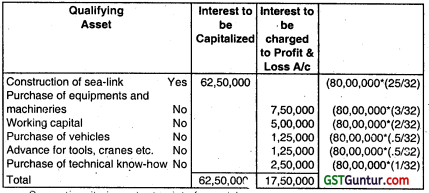
Question 99.
On 25th April, 2010 Neel Limited obtained a loan from the bank for ₹ 70 lakhs to be utilised as under:
: ₹ in lakhs
Construction of factory shed : ₹ 28
Purchase of Machinery : ₹ 21
Working Capital : ₹ 14
Advance for purchase of truck : ₹ 7
In March 2011, Construction of shed was completed and machinery installed.
Delivery of truck was not received. Total interest charged by the bank for the year ending 31st March, 2011 was ₹ 12 lakhs. Show the treatment of interest under Accounting Standard -16. (Nov 2011, 5 marks) [IPCC Gr. II]
Answer:
Treatment of Interest as per AS 16
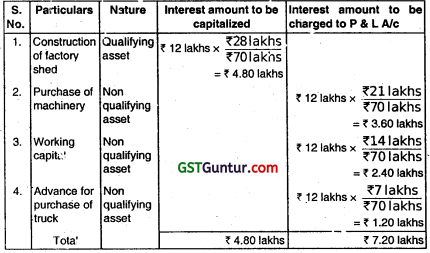
Assumption:
- It is assumed that construction of factory shed was completed at the end of March. 2011. Accordingly, interest for the full year has been capitalized.
- It is assumed that machinery was ready to use at the time of purchase only and on this basis it has been treated as non-qualifying asset.
Question 100.
Raj & Co. has taken a loan of US$ 20,000 at the beginning of the financial year for a specific project at an interest rate of 6% per annum, payable annually. On the day of taking loan, the exchange rate between currencies
was ₹ 48 per 1 USS. The exchange rate at the closing of the financial year was ₹ 50 per 1 USS. The corresponding amount could have been borrowed by the company in Indian Rupee at an interest rate of 11% per annum. Determine the treatment of borrowing cost in the books 0f accounts. (Nov 2013, 4 marks) (ÎPCC Gr. II)
Answer:
The following computations would be made to determine the amount of borrowing costs for the purpose of AS 16’ Borrowing Costs’:
Interest for the period = US $ 20,000 × ₹ 50 per US $ × 6% = ₹ 60,000.
Increase in the liability towards the principal amount
US$ 20,000 × ₹ (50-48) = ₹ 40,000. (A)
Interest that would have resulted it the loan was taken in Indian Currency
= US $20,000 × 48 × 11% = ₹ 1,05,600
Difference between interest on local currency borrowing and foreign currency
borrowing = ₹ 1,05,600 – ₹ 60,000 = ₹ 45,600 (B)
In the above case, ₹ 40,000(A) is less than ₹ 45,600 (B), therefore the entire
exchange difference of ₹ 40,000 would be considered as borrowing costs.
The total borrowing cost would be 1,00,000 (₹ 60,000 + ₹ 40,000)
![]()
Question 101.
Suhana Ltd. issued 12% secured debentures of ₹ 100 Lakhs on 01.05.2013, to be utilized as under:
Particulars : Amount (₹ in Lakhs)
Construction of factory building : 40
Purchase of Machinery : 35
Working Capital : 25
In March 2014, construction of the factory building was completed and machinery was installed and ready for it’s intended use. Total interest on debentures for the financial year ended 31.03.2014 was ₹ 11,00,000. During the year 2013-14, the company had invested idle fund out of money raised from debentures in banks’ fixed deposit and had earned an interest of ₹ 2,00,000.
Show the treatment of interest under Accounting Standard 16 and also explain nature of assets. (May 2014, 5 marks) [IPCC Gr. II]
Answer:
As per AS 16 “Borrowing Costs”, borrowing costs that are directly attributable to the acquisition, construction or production of a qualifying asset should be capitalised as part of the cost of that asset.
The amount of borrowing costs eligible for capitalisation should be determined in accordance with this Standard. Other borrowing costs should be recognised as an expense in the period in which they are incurred.
AS 16 also states that to the extent that funds are borrowed specifically for the purpose of obtaining a qualifying asset, the amount of borrowing costs eligible for capitalisation on that asset should be determined as the actual borrowing costs incurred on that borrowing during the period less any income on the temporary investment of those borrowings.
Thus, eligible borrowing cost
= ₹ 11,00,000 – ₹ 2,00,000 = ₹ 9,00,000
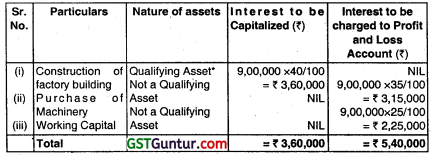
* Note : A qualifying asset is an asset that necessarily takes a substantial period of time to get ready for its intended use or sale.
Question 102.
M/s. Ayush Ltd. began construction of a new building on 1st January, 2014. It obtained ₹ 3 lakh special loan to finance the construction of the building on 1st January, 2014 at an interest rate of 12% p.a. The company’s other outstanding two non-specific loans were:

Building was completed on 31st December, 2014. Following the principles prescribed in AS 16 ‘Borrowing Cost’, calculate the amount of interest to be capitalized and pass one Journal Entry for capitalizing the cost and borrowing in respect of the building. (May 2015, 5 marks) [IPCC Gr. II]
Answer:
1. Calculation for Average Accumulated Expenses:

Out of above, ₹ 3,00,000 is from specific loan and balance ₹ 5,50,000 is from non-specific loans.
2. Calculation for Average Interest Rate:
- Total interest Exp. = (₹ 6,00,000 × 11%) + (₹ 11,00,000 × 13%)
= 66,000 + 1,43,000 = 2,09,000 - Total loan amount = ₹ 17,00,000
- Average rate \(=\frac{\text { Interest Exp. (i) }}{\text { Total Loan Amount (ii) }}\)
= \(\)[\frac{2,09,000}{17,00,000}/latex] × 100 = 12.29%
3. Calculation for amount to be capitalised:

4. Journal Entry

Question 103.
M/s. Zen Bridge Construction Limited obtained a loan of ₹ 64 crores to be utilized as under:
(i) Construction of Hill link road in Kedarnath:
(work was held up totally for a month during the year due to heavy rain which are common in the geographic region involved) ₹ 50 crores
(ii) Purchase of Equipment and Machineries ₹ 6 crores
(iii) Working Capital ₹ 4 crores
(iv) Purchase of Vehicles ₹ 1 crore
(v) Advances for tools/cranes etc. ₹ 1 crore
(vi) Purchase of Technical Know how
(vii) Total Interest charged by the Bank for the year ₹ 2 crores ending 31st March, 2016 ₹ 1.6 crores
Show the treatment of Interest according to Accounting Standard by M/s. Zen Bridge Construction Limited. (Nov 2016, 5 marks) [IPCC Gr. II]
Answer:
According to AS 16 ‘Borrowing costs’, qualifying asset is an asset that necessarily takes substantial period of time to get ready for its intended use. As per the standard, borrowing costs that are directly attributable to the acquisition, construction or production of a qualifying asset should be capitalized as part of the cost of that asset. Other borrowing costs should be recognized as an expense in the period in which they are incurred. Capitalization of borrowing costs is also not suspended when a temporary delay is a necessary part of the process of getting an asset ready for its intended use or sale.
The treatment of interest by Zen Bridge Construction Ltd, can be shown as:
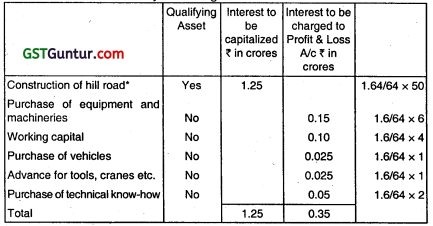
* Note: It is assumed that construction of hill road will normally take more than a year (substantial period of time), hence considered as qualifying asset.
Question 104.
M/s First Ltd. began construction of a new factory building on 1st April, 2017. It obtained ₹ 2,00,000 as a special loan to finance the construction of the factory building on 1st April, 2017 at an interest rate of 8% per annum. Further, expenditure on construction of the factory building was financed through other non- specific loans. Details of other outstanding non- specific loans were:

The expenditures that were made on the factory building construction were as follows:

The construction of factory building was completed by 31st March, 2018.
As per the provisions of AS-16, you are required to:
1. Calculate the amount of interest to be capitalized.
2. Pass Journal entry for capitalizing the cost and borrowing cost in respect of the factory building. (May 2019, 5 marks)
Answer:
(i) Computation of average accumulated expenses :

(ii) Calculation of average interest rate other than for specific borrowings:
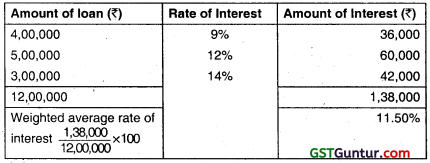
(iii) Interest on average accumulated expenses:

(iv) Total Expenses to be Capitalised for Factor” Building:

(v) Journal Entry

Question 105.
Answer the following question:
On 15th April, 2019 RBM ltd. obtained a Term Loan from the Bank for ₹ 320 lakhs to be utilized as under:
: ₹ (in lakhs)
Construction for factory shed : 240
Purchase of Machinery : 30
Working Capital : 24
Purchase of Vehicles : 12
Advance for tools/cranes etc. : 8
Purchase of technical know how : 6
In March, 2020 construction of shed was completed and machinery was installed. Total interest charged by the bank for the year ending 31st March, 2020 was ₹ 40 lakhs.
In the context of provisions of AS 16 ‘Borrowing Costs’ show the treatment of interest and also explain the nature of Assets. (Nov 2020, 5 marks)
![]()
Question 106.
A company incorporated in June 2017, has setup a factory within a period of 8 months with borrowed funds. The construction period of the assets had reduced drastically due to usage of technical innovations by the company. Whether interest on borrowings for the period prior to the date of setting up the factory should be capitalized although it has taken less than 12 months for the assets to get ready for use. You are required to comment on the necessary treatment with reference to AS 16.
Answer:
As per Para 3.2 to AS 16 ‘Borrowing Costs’, a qualifying asset is an asset that necessarily takes a substantial period of time to get ready for its intended use or sale.
Further, Explanation to the above para states that what constitutes a substantial period of time primarily depends on the facts and circumstances of each case. However, ordinarily, a period of twelve months is considered as substantial period of time unless a shorter or longer period can be justified on the basis of facts and circumstances of the case. In estimating the period, time which an asset takes, technologically and commercially, to get it ready for its intended use or sale is considered.
It may be implied that there is a rebuttable presumption that a 12 months period constitutes substantial period of time.
Under present circumstances where construction period has reduced drastically due to technical innovation, the 12 months period should at best be looked at as a benchmark and not as a conclusive yardstick. It may so happen that an asset under normal circumstances may take more than 12 months to complete. However, an enterprise that completes the asset in 8 months should not be penalized for its efficiency by denying it interest capitalization and vice versa.
The Substantial period criteria ensures that enterprises do not spend a lot of time and effort capturing immaterial interest cost for purposes of capitalization.
Therefore, if the factory is constructed in 8 months then it shall be considered as a qualifying asset: The interest on borrowings for the same shall be capitalised although it has taken less than 12 months for the asset to get ready to use.